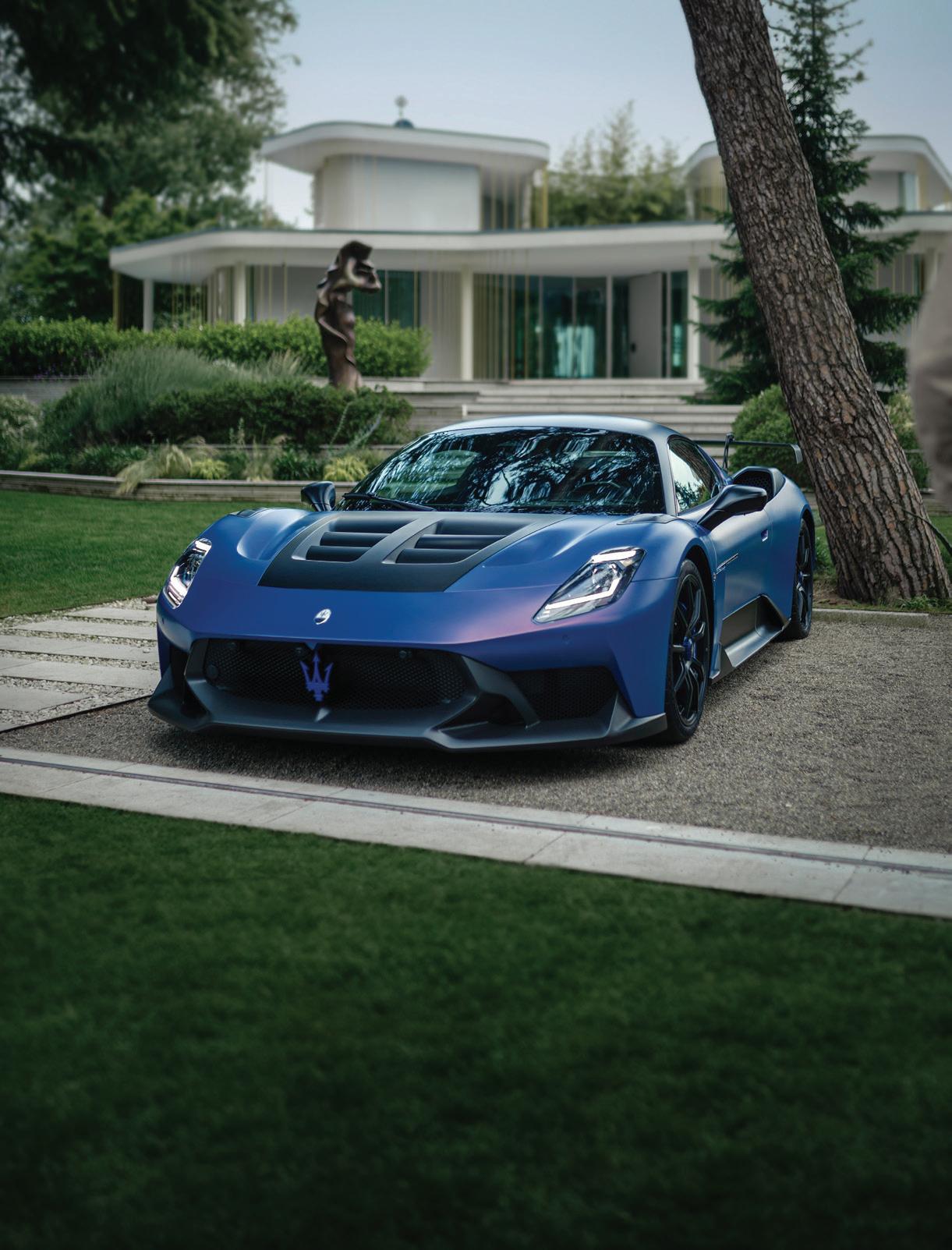
















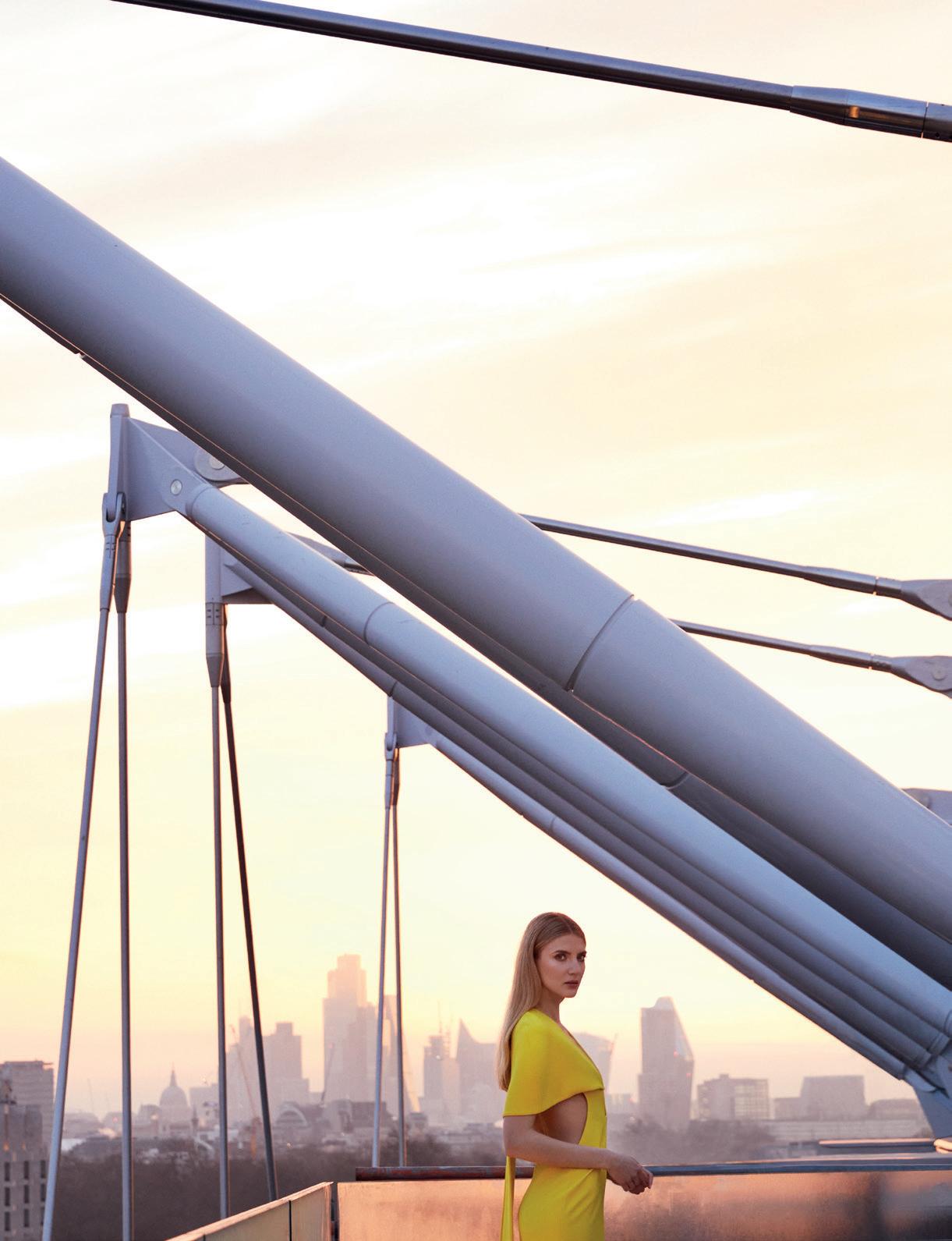

Brought to you by Maybourne, The Emory is a modern masterwork by Richard Rogers and Ivan Harbour.

Forty Staying Cool Entrepreneur, actor and hip hop royalty, LL Cool J talks vulnerability, longevity and the call he got telling him to stay off the streets.
Forty Six My Way
She’s one of the few women heading a top fashion house — and Maria Grazia Chiuri of Dior has been determined to it her way.
Fifty Four The Original Influencer
One of the most enduring fashion legends in history, Marilyn Monroe’s style is now the subject of a new book



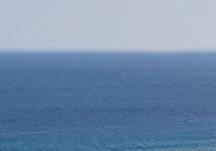







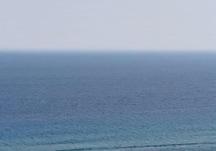
















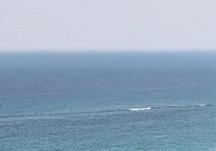
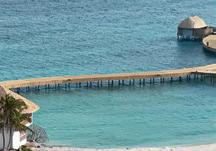







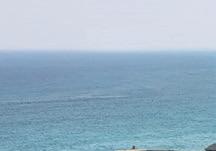



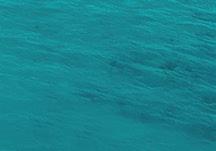




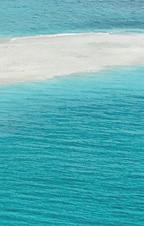


Eighteen Radar
Twenty Objects of Desire
Twenty Two Art & Design
Twenty Eight Jewellery
Thirty Six Timepieces
Sixty Four Gastronomy
Sixty Eight Travel
Seventy Two What I Know Now

Sixty Motoring
How the McLaren 750S is not only the most powerful series production it has ever produced, but also its most enjoyable.
Editor-in-Chief & Co-owner
John Thatcher john@hotmedia.me
COMMERCIAL
Managing Director & Co-owner
Victoria Thatcher
PRODUCTION
Digital Media Manager Muthu Kumar
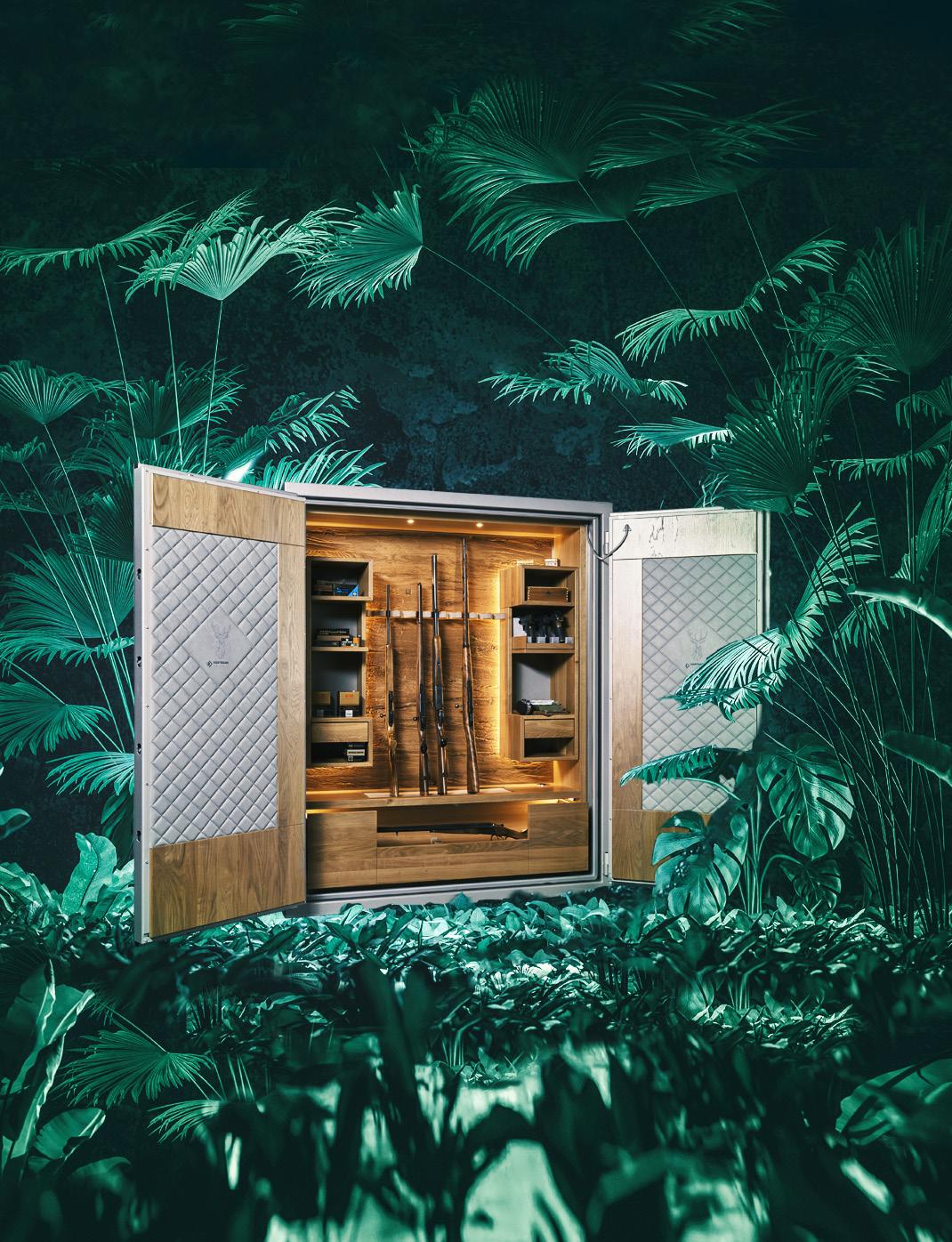

2024
As a premium service provider in the Middle East serving the private and business jets of the region and beyond, we are truly committed to the standards of the DC Aviation Group of companies. We are striving to deliver the highest level of quality in all areas, driven by the know-how of our people and their dedication to the business.
Be it for an aircraft owner, charter passenger, or even the flight and cabin crew, private and business jet travel revolves around time saving and maximum comfort. If you are travelling to and from Dubai, DC Aviation Al-Futtaim is your perfect choice.
From our exclusive FBO and hangar facility at Al Maktoum International Airport, we are able to save you time and offer you a luxurious ambience, whether you’re departing or arriving in your aircraft. We operate the only integrated private and business jet facility within the Dubai World Central (DWC) district where slot and parking restrictions are a matter of the past. With Dubai International Airport becoming the world’s busiest airport, private and business jet flights are severely restricted. However, that is not the case at Dubai’s new hub for executive aviation.
We welcome you onboard, and trust you’ll enjoy your flight experience — as well as our 100 percent satisfaction promise.
Holger Ostheimer Managing Director, DC Aviation Al-Futtaim

Category-leading aircraft is a compelling combination of speed, efficiency and cabin size

‘ This G400 aircraft model exemplifies our dedication to offering the highest standards of safety, cabin convenience and reliability to our customers’
Svenja Wortmann, Managing Director, DC Aviation
Gulfstream Aerospace Corp has announced the first Gulfstream G400 intended for dedicated charter operations has been purchased by Germanbased DC Aviation Group. The sale was announced during a signing ceremony at Gulfstream’s Customer Support facility in Farnborough, England.
“We appreciate DC Aviation’s commitment to and confidence in the G400, bringing this category-leading aircraft to European charter customers,” said Scott Neal, senior vice president, worldwide sales, Gulfstream. “The compelling combination of speed, efficiency and cabin size of the G400 fills a much-needed void in its category. We are seeing strong demand for this aircraft in Europe and around the world.”
The all-new G400 made its first flight on August 15, officially launching the
aircraft’s flight test program, and boasts class-leading performance and efficiency thanks to the combination of Gulfstream’s aerodynamic clean-wing design and advanced Pratt & Whitney Canada PW812GA engines. The aircraft also features Gulfstream’s next-generation avionics and technology, including the Gulfstream Symmetry Flight Deck with the industry’s first active control sidesticks, most extensive use of touch-screen technology and the award-winning Predictive Landing Performance System.
The G400 can connect important business hubs like Munich to Mumbai; Zurich to New York; or Geneva to Dubai; among other nonstop flights, all at speeds faster than any aircraft in its market segment.
In the cabin, G400 customers will benefit from the Gulfstream Cabin Experience with 100% fresh, never recirculated air;
a plasma ionization clean air system; the lowest cabin altitude in its class; and abundant natural light from 10 Gulfstream Panoramic Oval Windows. With a choice of three floorplan options with seating for up to nine, 11 or 12 passengers, the G400 offers a spacious and flexible interior.
“We are extremely proud to be pioneering this new aircraft model in Europe,” said Marc Ambrosius, managing director of DC Aviation Group. “The introduction of the G400 demonstrates DC Aviation’s constant commitment to providing a premier travel experience for our clients.”
“This G400 aircraft model exemplifies our dedication to offering the highest standards of safety, cabin convenience and reliability to our customers,” added Svenja Wortmann, also managing director of DC Aviation.
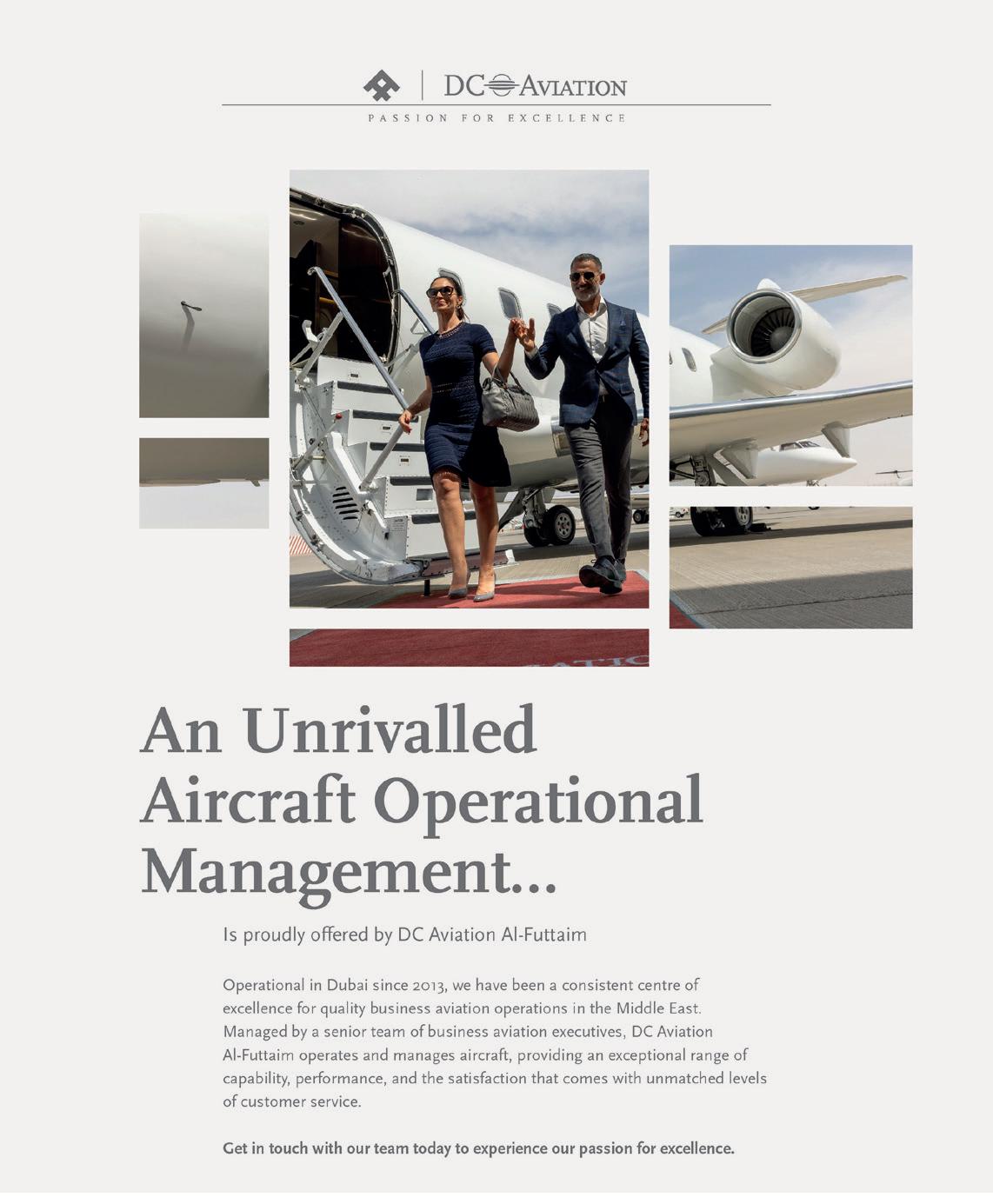
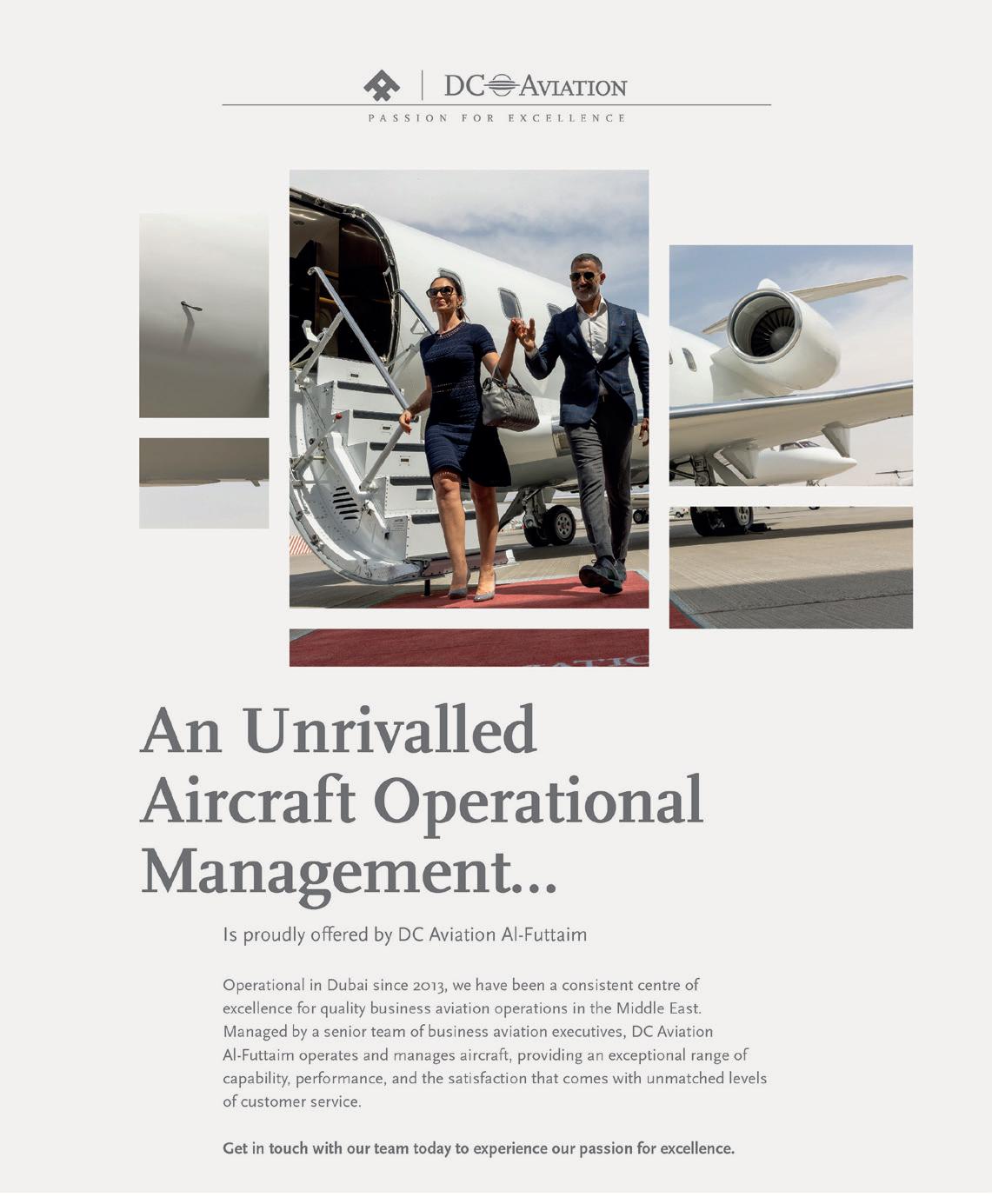


DC Aviation Al-Futtaim (DCAF) was born as a joint venture between the Al Futtaim Group, a local, regional, and international powerhouse with its headquarters in Dubai, and DC Aviation GmbH, with its main base in Stuttgart, Germany.
The business was officially launched during the 2013 Dubai Airshow. A grand opening ceremony in the presence of Mr. Omar Al-Futtaim, the Vice Chairman of Al-Futtaim Group, as well as dignitaries and honorable guests from within the aviation industry, took place within the impressive hangar structure and home of DC Aviation Al Futtaim at Dubai World Central.
His Highness Sheikh Ahmed Bin Saeed Al Maktoum, the President of Dubai Department of Civil Aviation, hailed the company’s launch as, “another milestone in Dubai’s ongoing development as a global aviation hub.”
Over the intervening years we have steadily grown our level of activity as well as our service offerings. We began by providing VIP passenger aircraft handling and hangar parking services, and soon established a line maintenance station covering different aircraft types and nationalities of registrations. Since being granted an aircraft operator certificate (AOC) by the General Civil Aviation Authority of the United Arab Emirates, our fleet of managed aircraft has continued to grow and currently sits at 11, with two for charter. As of now our services include executive charter; 360-degree aircraft management; aircraft
maintenance; aircraft hangarage; consulting services; and FBO and handling services.
Our FBO is particularly impressive, offering the shortest distance between arrival to take-off. The first full-fledged facility at Al Maktoum International Airport (DWC), it provides the highest levels of privacy and discretion and boasts a 1,300 m² lounge area, shower areas, a large conference room, individual TV, WLAN access, and a modern interior design. Additionally, 24 hours on-site security and customs and immigration services are provided, along with covered private parking slots for passengers and their guests. When it comes to aircraft management, we offer allround support under one roof in line with the highest industry standards. Our client-orientated service can help customers maximise the retention value of their aircraft, make savings on things like insurance, fuel costs, and crew deployment, and reduce the costs of owning an aircraft by making it available for charter at your request.
Maintaining aircraft is our forte. We handle line maintenance for Global Express, Challenger 604/605, Falcon 900EX and Falcon 7X/8X aircraft, along with limited Airbus A320 series support; overhaul and renewal cabin equipment with the support of local partners; offer 24/7 spare parts supply, procurement and storage; maintenance and airworthiness certification; the development and management of maintenance programmes; pre-purchase and technical inspections;
A private island of great natural beau , the Ummahat archipelago brings a rare environment to The St. Regis Red Sea Resort, where conscious indulgence sets the stage for captivating moments. A glamorous hideaway, it offers a secluded retreat where intimate gatherings, landmark anniversaries and romantic weddings can be celebrated. Cra ed to exacting preferences, the team are on hand to arrange every detail, down to the minutia, to ensure a celebration of singular experience and cherished memories.

For reservations, or more information please email reservation.redsea@stregis.com Ummahat Island 1, Red Sea, Saudi Arabia t. +966 14 504 0000 stregisredsearesort.com
One hundred original pieces from pop art pioneer Andy Warhol (1928–1987) are on show in Dubai this month. Making their debut in the UAE, the articles — curated by Nada Ghandour for Art for All — span screenprints, photos and magazines and are showcased within two immersive spaces designed by New York-based architect Ibrahim Kombarji. The first highlights Warhol’s career milestones; the second his iconic portraits of cultural titans, including the likes of Marilyn Monroe, Elizabeth Taylor and Mick Jagger. “This exhibition offers a remarkable opportunity to explore Warhol’s innovative approach to art and his profound commentary on consumerism and celebrity culture,’ said Ghandour.
AndyWarhol,TheGlamFactoryis anexhibitionbyArtforAllhostedat Foundry,DowntownDubai,throughout October


Master craftsmanship, effortless style and timeless appeal; this month’s must-haves and collectibles

Designed to comprise a spellbinding performance that unfolds over three acts – music, dance and magic – Chaumet’s latest high jewellery collection is characterised by beautifully considered –and lovingly crafted – pieces. To capture music, three sparkling sets emblazoned
with emeralds, sapphires and diamonds feature an array of musical motifs, while contemporary spirals are a feature of the big-stone-centric ode to dance. Magic takes the form of pieces like this bewitching tiara, a longtime signature of the house.
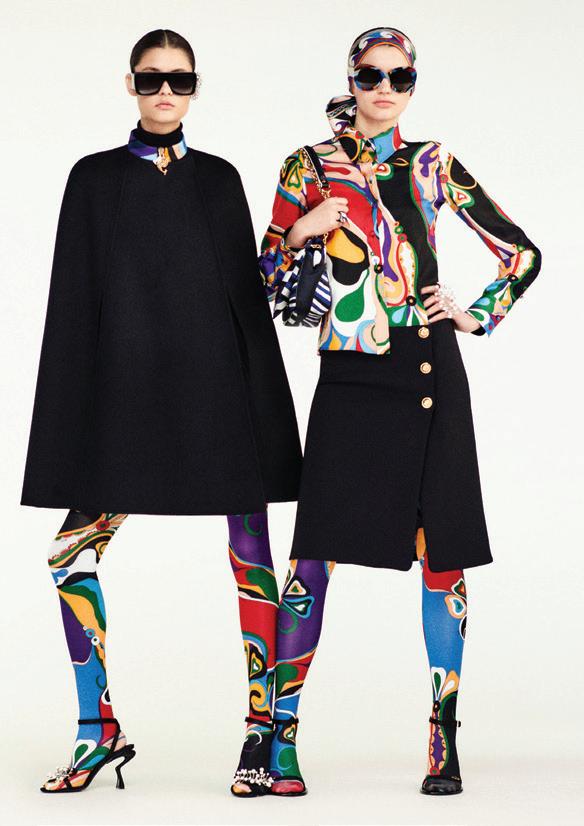
Pucci’s Creative Director, Camille Miceli, has plucked ideas from two disparate sources of inspiration for her FW24 collection – the lavish outfits of late music icon Prince, and the embellished, figure-hugging outfits worn by figure skaters. It makes for a potent mix in which
OBJECTS OF DESIRE 2
glamour is the key ingredient: A-line skirts and blouses with taffeta balloon sleeves, ultra slim suits bearing glittery stripes, and 70s-style dressy ensembles. As ever, multicolour prints play out throughout the collection, on trousers, dresses, tops and signature kaftans.

JESSICA MCCORMACK TAPESTRY
London’s queen of diamonds – and reigning champion of uniquely designed pieces big on personality – Jessica McCormack has turned her creative gaze to the humble friendship bracelet. Eschewing frayed material in favour of diamonds and coloured sapphires,
McCormack’s Tapestry weaves its magic across colourful stripes and chevrons. Underpinned by solid gold, it makes for a bracelet that feels as smooth as ribbon on the skin. In addition to its bracelet form, Tapestry comprises earrings and cuffs. We suggest making Jessica your bestie.


OBJECTS OF DESIRE

RANGE ROVER
SPORT SV EDITION TWO
The latest iteration of Range Rover’s high-performance flagship vehicle is also its most powerful and dynamic to date, with twin turbo V8 engines that help you accelerate from 0-100km/h in as little as 3.6 seconds. It takes much longer to fully
appreciate everything else this refined vehicle offers (particularly its myriad technologies), which is available in four distinct hues - blue nebula, marl grey gloss, sunrise copper satin, and ligurian black gloss – and comes with a whole host of customisation options.
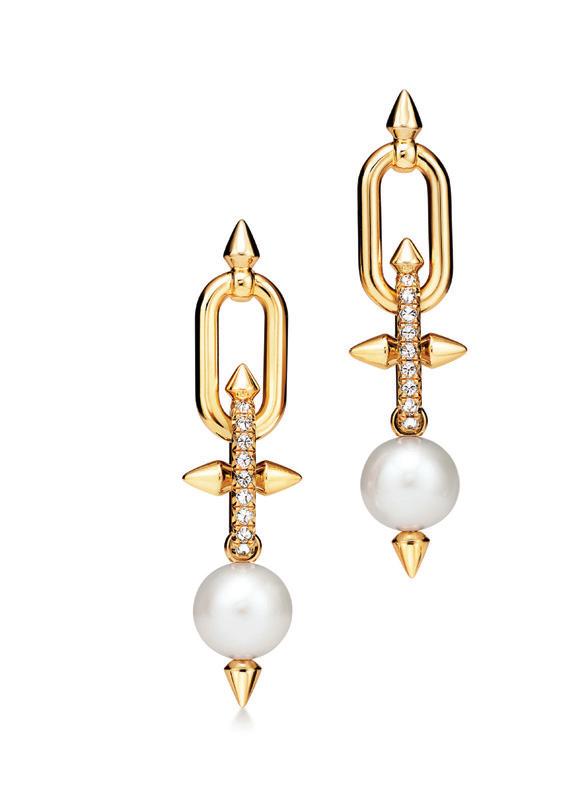
Enhancing the collection he debuted for Tiffany in the summer, Pharrell Williams introduces freshwater pearls to add a demure touch to his trident-of-Poseidon inspired pieces. Used to reference a symbol of fearless individuality, the spear-shaped motif is softened with a
curved link, with the use of pearls further tempering the trident’s pointed edge. “In Japan, it was believed that pearls were created from the tears of mythical water creatures; so I naturally gravitated towards them as a means of expressing this connection to water,” says Pharrell.

While Chopard’s Ice Cube collection has received a further injection of cool by bringing in Bella Hadid to front its new campaign, the maison’s mains d’art have been busy crafting pieces for a high jewellery capsule. Though the cube remains the central creative pillar,
Chopard’s craftspeople were tasked with creating a choker and bracelet that feature individually-shaped cubes of varying height, designed to reflect the jagged skyline of a modern metropolis. When worn, the flexible pieces attach themselves like a second skin.
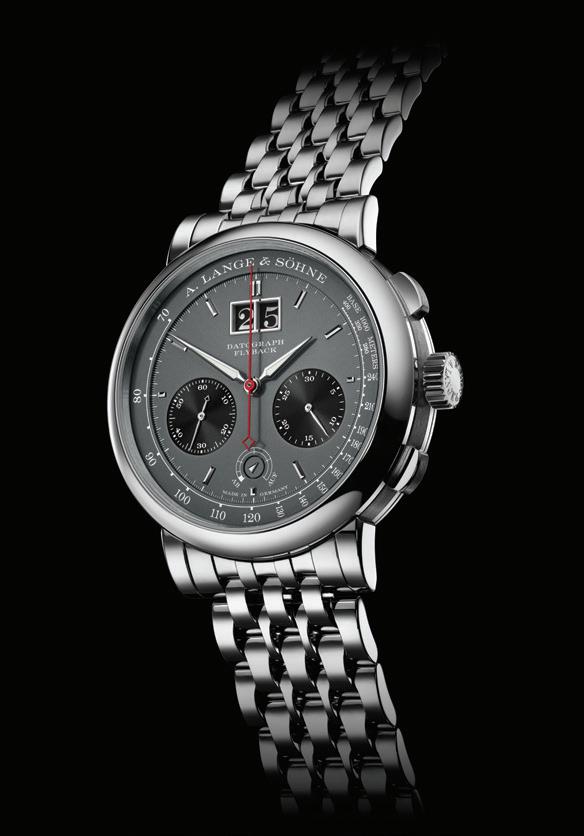
A. LANGE & SÖHNE
DATOGRAPH UP/DOWN ‘HAMPTON COURT EDITION’
To celebrate the 25th anniversary year of its first chronograph calibre, A. Lange & Söhne has created a one-of-akind Datograph Up/Down timepiece, which will be auctioned for charity by Phillips in Geneva next month. The ‘Hampton Court Edition’ – named
in relation to this year’s Concours of Elegance at the UK’s Hampton Court Palace – debuts a blend of white-gold case, grey dial with black subsidiary dials, and an engraved hinged cuvette. Adding a racy touch is the red chrono seconds hand.


Opening pages, from left to right: Fin DAC; Warhol-Yuansu
This page, from top to bottom: Basquiat-Luoro; Lichtenstein-Yehua
Opposite page: Reid-Child of Seditionaries
You wouldn’t suspect that someone who struggles with vertigo would be particularly keen to take on a commission to paint a 200ft mural of Frida Kahlo on a wall. But then Fin DAC, who did just that in Guadalajara, western Mexico, in 2019, isn’t one to do what you expect. And neither does he want to be. “I’ve been an outsider since the start and hope to remain that way,” says the man lazily labelled the ‘Irish Banksy’ by some media outlets, by virtue of him being a street artist. “My goal was always to just do my thing and let others worry about the rules, regulations and all the other stuff they claim you can’t or shouldn’t do. Creativity is an individual pursuit and it shouldn’t need the seal of approval or validation of self-anointed gatekeepers, governing bodies or hierarchies.”
While Banksy remains anonymous, did Fin DAC always intend to put a face to his work? “Not at all. In my early days I was completely anonymous, even using a dragon logo to sign my murals instead of my name. I think that over time, and as street art became more and more mainstream, I just dropped the pretence that I needed my identity to be secret.”
It’s certainly no secret that Fin DAC’s works are now hot property, with his many murals brightening cities across the globe – from Melbourne to Miami – and his canvases and sculptures drawing an ever-growing crowd of collectors. One online concept, 24, saw one of his prints put up for sale every hour across a 24-hour period. Each one sold in a matter of minutes. In 2022, he teamed up with Bang & Olufsen to reimage the brand’s Beoplay A9 speaker as a work of art – it also sold out. That same year, with an estimate of £12-18,000 ($1523,000k), his original artwork Holangi achieved £50,800 ($65,000) when auctioned by Phillips, his record so far. What does that level of success feel like? “It’s great that it happens but it’s not something I feel the need to pat myself on the back for or brag about. I’m not a household name and very few people in the art world even know who I
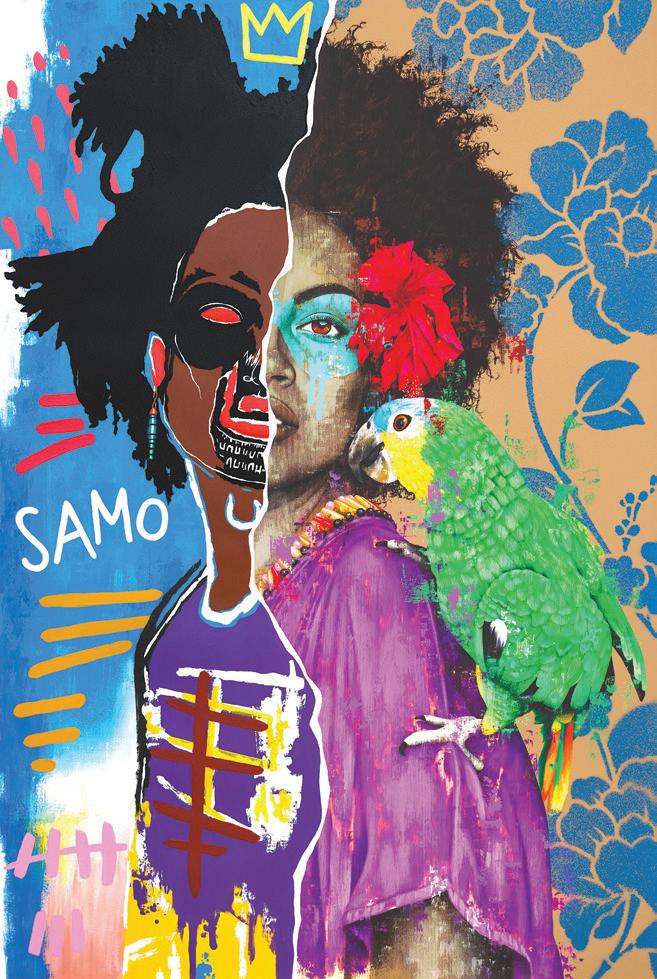
‘ My goal was always to just do my thing and let others worry about the rules, regulations and all the other stuff they claim you can’t or shouldn’t do’
am, so it’s quite easy to remain humble.” Next up sees Fin DAC – the name a mashup of his real name, Finbarr, and the acronym Dragon Armoury Creative, the original name of his virtual portfolio – present HomEage in London’s underground crypt gallery at St Martin-in-the-Fields, Trafalgar Square, his first solo show in three years.


Across 24 on-paper artworks, it pays unique homage to icons of the art world; those whose work has inspired Fin DAC, with half the artwork painted in the signature style of the chosen artist, and the other half distinctly Fin DAC. Why did he decide now was the right time to honour his inspirations? “The covid pandemic was actually the initiator: utilising a lockdown period in California right at the start of it all to arouse feelings of home and my youth and the artists that inspired me in those days. The project has been something I’ve dipped into intermittently over the last four years, fitting it in around other projects and commitments. I can’t particularly say that this is the right time but I’ve built up enough of a collection of artworks that I’d like people to be able to see in the flesh.”
Fin DAC’s work depicts females, mostly Asian or Eurasian, and typically with a mask across their eyes. He said he started out painting Asian women because they appeared to suffer the least positive depictions. “I just wanted to represent women in a more positive light without resorting to objectification or over-sexualisation. And I guess that was a hark back to the type of portraiture that I loved from times gone by, before the westernisation and homogenisation of the world.”
He’s gleaned a lot of ideas from travel. “If your outlook isn’t expanded by travel then there’s something seriously wrong. Travel gave me first hand experiences of cultures, communities and traditions that I would have known little or nothing about without it.”
Self-taught, it wasn’t until he’d entered his forties that Fin DAC had the confidence to devote himself to art, quitting his day job. “Sometimes I wish I’d started earlier, just so I could be happy in the knowledge that I had loads of time left to do all the things I want to do. But I’m more than aware that it happened at the time it needed to for me and nothing I could have done would have made it happen sooner. Everything aligned in the way it did for the right reasons and luckily I was ready for it. I mean, it might not have happened at all.”
Go to see HomEage and you’ll be glad it did.
HomEage will be open to the general public on October 25-26, The Gallery in the Crypt at St Martin-in-theFields, Trafalgar Square, London
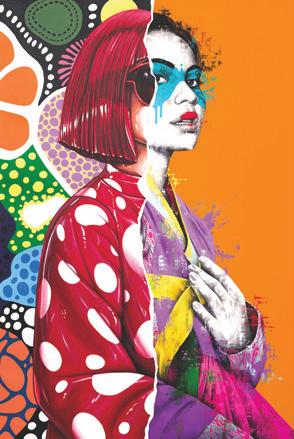
‘ Success is great, but it’s not something I feel the need to pat myself on the back for or brag about ’




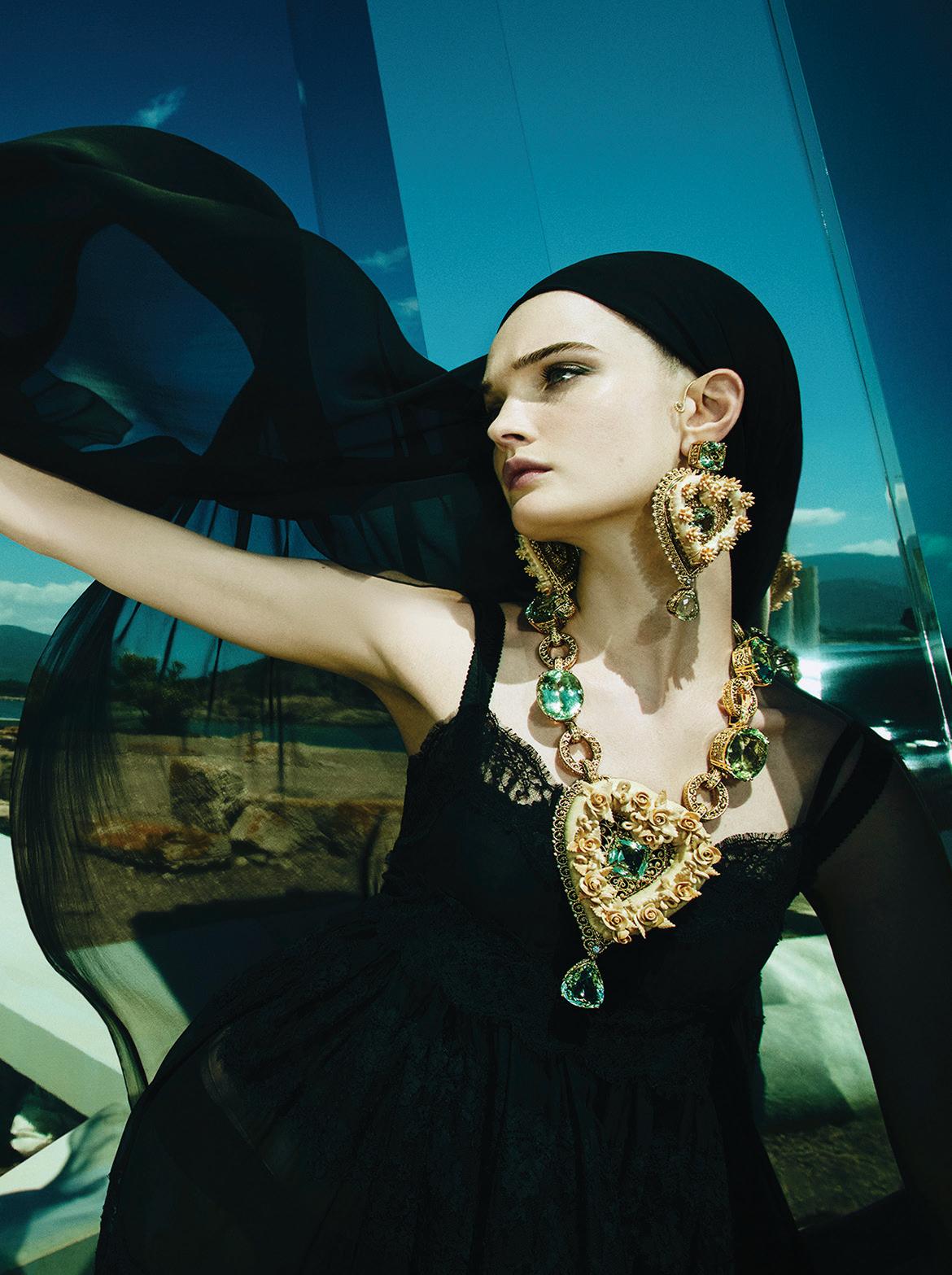

Set like a jewel in the sapphire waters that frame its unblemished coastline, the Italian island of Sardinia is an historical treasure. It’s a rugged land of myth, beauty, and, above all, tradition, embedded in its ancient towns and villages and represented by its myriad crafts, customs and abundant artistry.
It’s this rich history that Domenico Dolce and Stefano Gabbana honoured in their latest Alta Gioielleria Collection, lovingly composed of 90 one-of-a-kind masterpieces.
“We were inspired by the Sardinian
goldsmith tradition of the filigree, a distinctive method characterised by a golden openwork structure that evokes the ephemeral delicacy of lace,” outlined the designers. “We’ve also been inspired by the bread and pasta making, with its carvings and delicate decorations: each design has a meaning, it is a wish for good luck. Behind every decoration there is a universe full of values linked to this beautiful island”
As the designers touch upon, filigree is an ancient technique – which, legend has it, began at the hands of
Sardinian witch-fairies some 2,000 years ago – that continues today, for which highly skilled craftspeople weave patterns from delicate threads of gold or silver. Its use in this spellbinding collection adds much to its obvious allure. Yet it’s the use of outsized gems – several sized between 50 and 100 carats – that really take the eye: the likes of yellow beryl, kunzite, rubellite, aquamarine, amethyst and Brazilian quartz painstakingly transformed by hand into colourful works of art that speak of a land of rare magnificence –and designers at the top of their game.
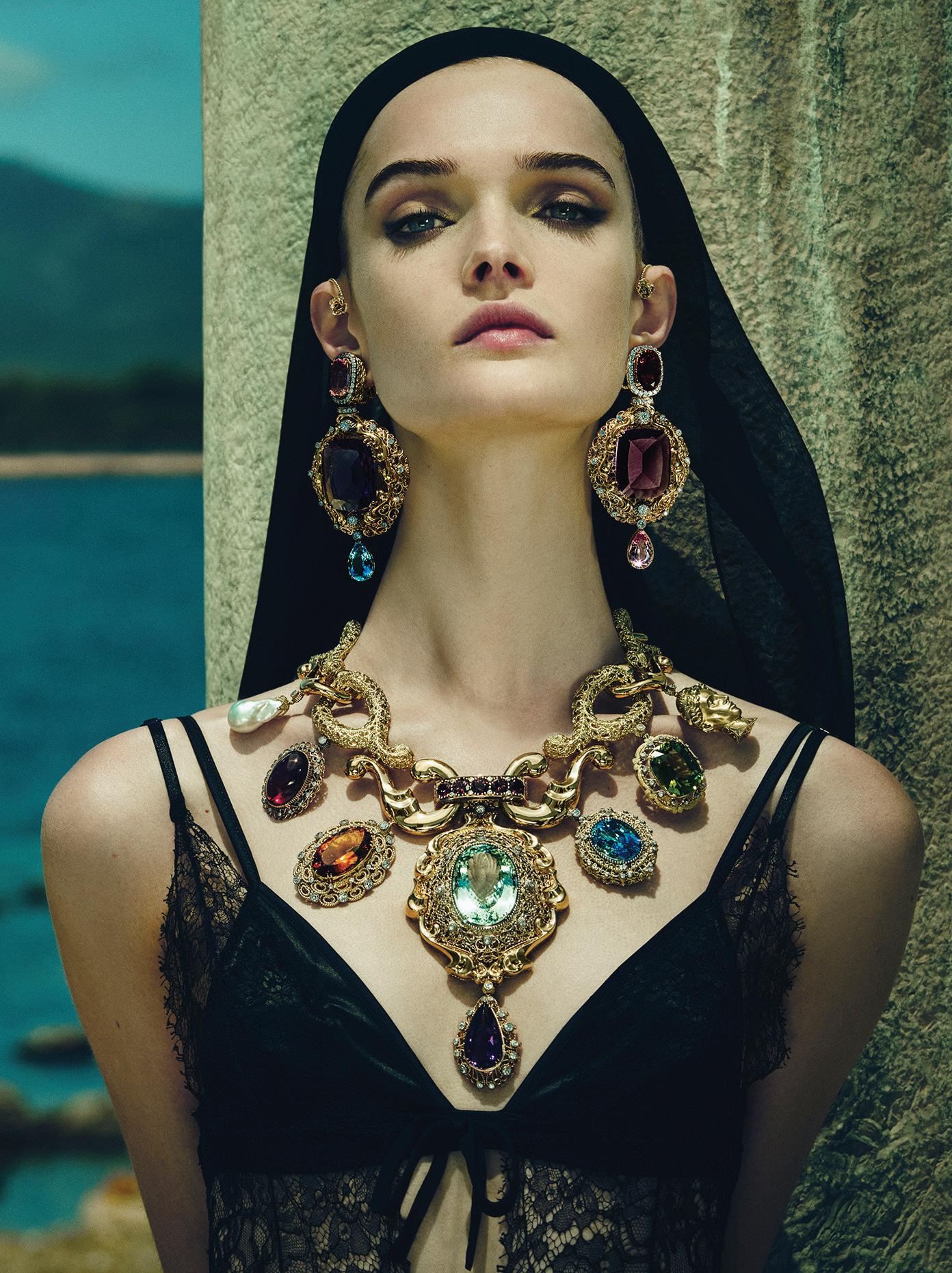

Boucheron’s latest high jewellery collection is inspired by Iceland’s extraordinary landscape. Jessica Diamond talks to the creative powerhouse behind the innovative designs
WORDS: JESSICA DIAMOND
Like many jewellery maisons, Boucheron often looks to the natural world for ideas, but it takes a creative director like Claire Choisne, who’s been at the Place Vendôme jewellers since 2011, to take a more unconventional approach to the theme. The source of inspiration for her latest high jewellery collection is water — an expansive and tricky subject to get a handle on.
“I already knew I wanted to do something that shows the beauty of water,” she says from Boucheron’s Paris HQ, “but I wanted it to be different.”
Cue a ten-day research trip to Iceland in April 2022 to explore the barren, volcanic and icy landscape. “Maybe I should have chosen the Maldives or the Seychelles,” she jokes, “but it wasn’t the kind of water I wanted to represent. It was too cute, too blue and too sunny.”
The resulting 26-piece Or Bleu collection is characterised by chunky forms, a moody palette of predominantly black and white and Choisne’s customary incorporation of unusual materials. Top of her wish list to visit was Diamond Beach with its black volcanic sand and fragments of ice strewn along the shoreline. It inspired much of the collections monochrome colouring, including the Black Beach necklace. “I loved the contrast between the shiny white ice and the black sand,” she says. “Of course I can mimic the water and ice with diamonds, but it was the black sand that was a challenge.” The solution was to use the real thing with Boucheron’s innovation team working out how to bind the sand with a polymer and spray it layer by layer to build up a 3D shape. The resulting



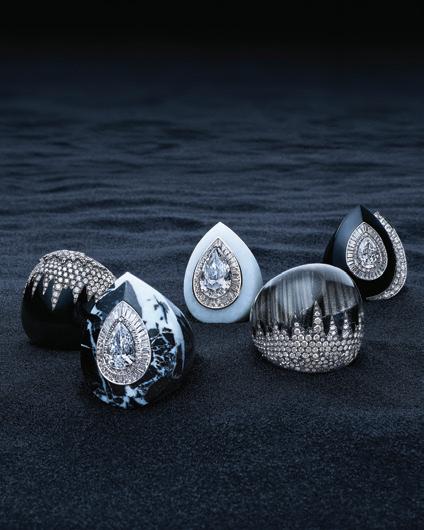

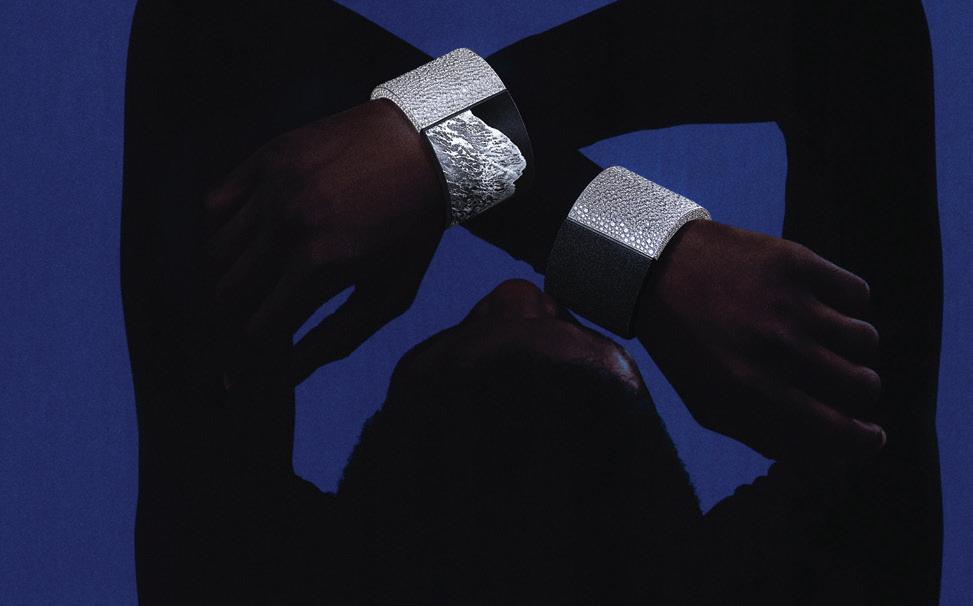
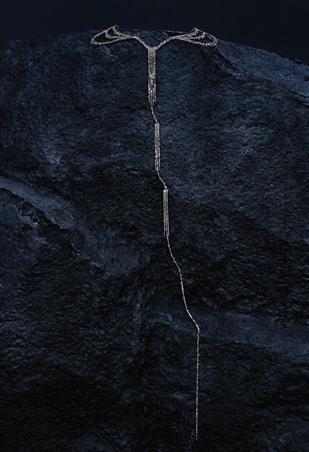

‘This piece took the most number of hours of anything we’ve made since I’ve been at Boucheron, more than 5,000 in total ’
torque necklace and earrings are a startling matt black with a velveteen texture.
More black, this time in the Eau d’Encre bracelet made from black obsidian, a form of natural volcanic glass. “You find it a lot in Iceland,” she says of the material that is also used in a set of rings, along with black and white veined marble (“the pattern looks like ice from the sky”), titanium and cloudy white jade. In a standout pair of shoulder brooches made to look like water cascading over shoulders, aluminium is coated in chromium to make the pieces light and extra shiny. The house signature of using carved rock crystal in its creations found an easy fit in Or Bleu. In the Ice Cave bracelet it’s polished and shiny to mimic the country’s caves’ soaring interiors, while in the Iceberg necklace the rock crystal is matt and “frosted” with each piece of crystal carved to mimic a diamond, facets and all, but left unpolished as if the “diamonds” have been frozen.
In the Ondes set of two rings and a statement necklace, Choisne wanted to emulate drops of water radiating out on the surface. “This piece took the most number of hours of anything we’ve made since I’ve been at Boucheron,
more than 5,000 in total,” she says. A software package called Blender was used to mimic realistic water movement and patterns before the craftsmen carved the crystal and set diamonds underneath it. Both rings are designed to be worn together, “like rain falling on your hand”, she says.
Despite all this innovation, Boucheron’s heritage still informs the collection. In the Vague earring, inspiration has come from a tiara from the archive from 1910 based on Hokusai’s wave, while a cascading diamond Flots brooch was inspired by a comb from 1901. Perhaps the most conventional piece in the collection is the only one to use colour — the Or Bleu necklace — which is made from a set of hexagonal aquamarines that Choisne found at the Tucson Gem Fair in Arizona. “I started with the stones, when usually I would start with the design — these were just too amazing to turn down.”
But back to the Iceland trip. “It was really different and I loved it,” Choisne says. “It wasn’t easy — at times it was minus 20C outside — but I fell in love with it and all the powerful, strong variations of water that we saw.” Her collection of impactful and original jewels are certainly testament to that.

High up in the Jura mountains, as the road narrowed and other cars became noticeably outnumbered by ambling cows, clouds heavily pregnant with the threat of rain hovered low to meet the fir trees and verdant pastures that paint the landscape of Les Breuleux in myriad shades of green. They dropped like a veil, as if shrouding a closely guarded secret, before parting peacefully to reveal it – the Richard Mille manufacture, a modern, low-rise facility at odds visually with its natural surrounds but very much in tune with the tradition of watchmaking, which stretches to centuries in this sleepy slice of Switzerland, where time seems to pass at a slower pace. But not so for Richard Mille.
Since 2001, when its very first timepiece was launched – in more ways than one, as its creator threw the watch to the ground before a shocked audience at that year’s Baselworld to prove an unmatched robustness that is now somewhat of a brand signature – Richard Mille has moved at a lightening pace to occupy its position at the forefront of avantgarde watchmaking. The hallmarks were there in that emblematic RM 001 Tourbillon, which was limited to just 17 pieces and carried a sixfigure price tag – the world’s first torque indicator, a titanium baseplate and ergonomic case – and it’s in this state-of-the-art facility that such groundbreaking watches are crafted, by machine and by hand, from many exceptional materials.
It’s also here, on the grounds where watchmaking facility Guenat S.A. Montres Valgine (GMV) was raised more than a century ago, where Richard Mille’s remarkable success story began. A direct descendant of the man who built it, Dominique Guenat took over as owner in 1991 and as the decade drew to a close he was contacted by an old friend who had a vision for a unique watch free of creative, corporate and financial constraints. That friend was Richard Mille, and in 2001 the pair established their new brand.
Richard Mille began operating from the premises of GMV, before its rapidly achieved popularity led


‘ We see how human and machine work in harmony ’


to a series of expansions on the wider plot. Today, the buildings here enable the brand to not only machine its own essential parts but to also incubate the many ideas that challenge convention within the watch industry. This is where the magic happens. Across multiple rooms and stations we see how human and machine work in harmony to grind, polish, and assemble the movements – fifteen of which are fully created in house – and finished timepieces. How, because every element of a Richard Mille watch is visible, the finest details are painstakingly finished by hand. How the brand’s flagship tourbillon is handled in near reverential silence by the single watchmaker assigned to it. And learn how all the while there is dialogue between the developers and watchmakers aimed at achieving what other brands would deem impossible.
But what’s initially hard to fathom as you tour the premises is the vast amount of machinery and equipment employed to create something as

‘ In scrupulous house tests watches are dropped and hit with a pendulum ’
small as a watch. But then these are not your average watches – and neither are their materials, many of which Richard Mille introduced to watchmaking from the aeronautic and automotive industries, hence the tagline: a racing car on your wrist. Carbon nanofibre is one such material. Commonly used in aerospace engineering, these individual fibres are slimmer than a strand of human hair, but when mixed with a polymer and subjected to extreme temperatures and pressure form a supremely strong yet equally lightweight material. In what was a world first, it was used to form the movement baseplate of 2004’s RM 006 Tourbillon Felipe Massa, which the racing driver would wear on track, the 43-gram watch able to resist the g-forces of F1. A 2017 collaboration with McLaren led to the RM 50-03, for which Graph TPT® was used in watchmaking for the very first time. It’s six times lighter than steel but some 200 times stronger. 2014 saw Carbon TPT® introduced.



It’s now the brand’s most used material, lightweight but so strong and durable it reduces the occurrence of microcracks by 200%. It debuted on the RM 35-01 Rafael Nadal, whose need for a watch that could withstand the significant pressure his ground strokes generate was paramount. Which leads us nicely to the fun part of the factory tour.
To ensure such Richard Mille models can withstand extreme shocks they are scrupulously tested in house, which means, among other things, being dropped and hit. To do this, machines were specifically created for the launch of the first Rafael Nadal watch, including the Mouton Pendule, a pendulum that literally smashes into the finished watch at a speed of 15km/h. It does so once on the glass, once on the crown, and once at the 9 o’clock position. Rigorous. By the end of 2023, 63,000 Richard Mille timepieces had passed through this environmentally conscious factory, the majority of which have changed the world of watchmaking forever. The challenge to create the next one has already been gladly accepted.

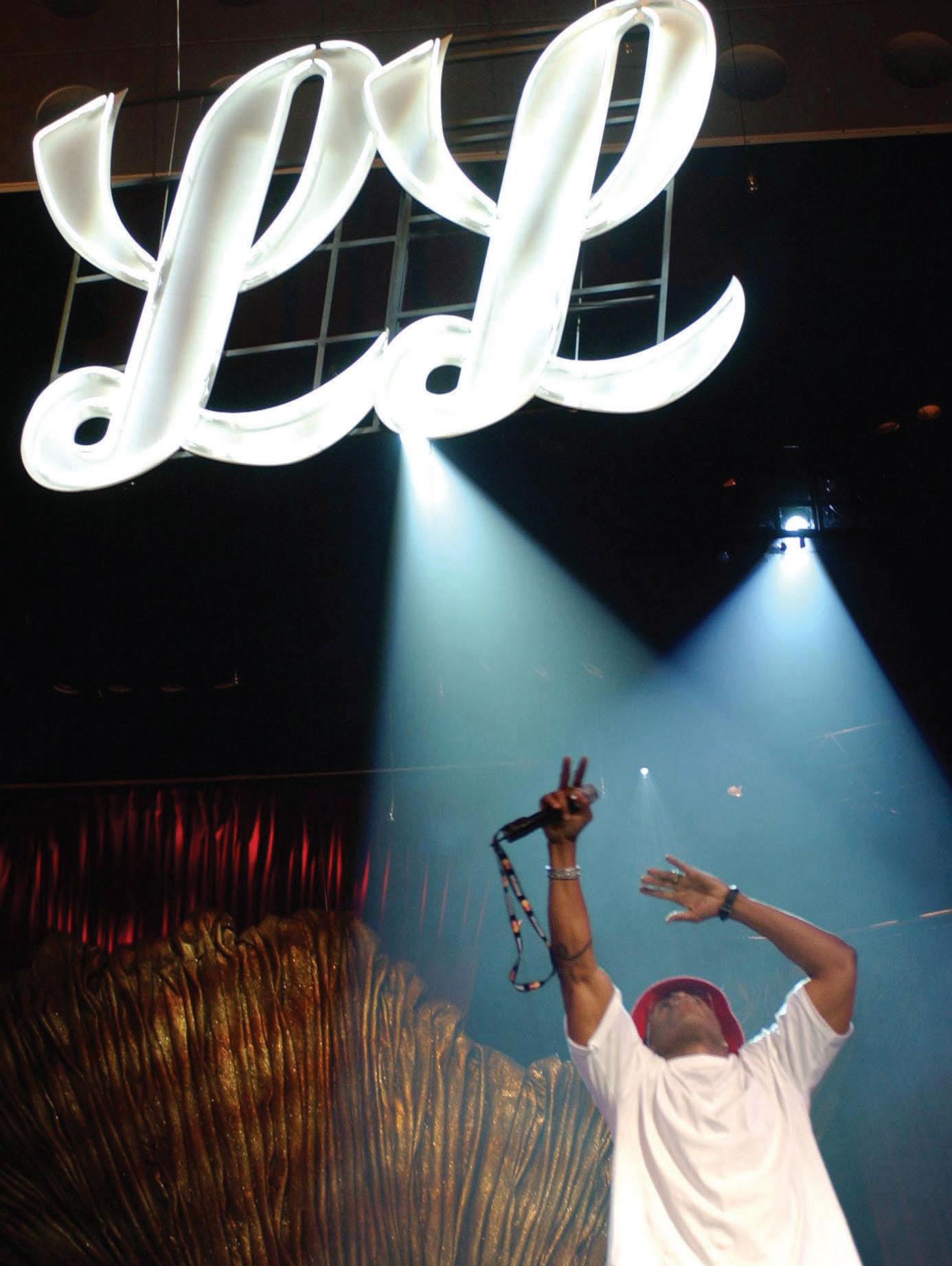

The walls of LL Cool J’s office in his New York home groan under the weight of framed gold and platinum discs. But these trophies aren’t mere self-celebratory décor – they serve a serious, inspirational purpose for the rapper, actor and entrepreneur. “When I look at these discs,” he murmurs, humble as rap’s finest braggart can be, “they remind me that everything is still possible, that I can do more. They’re symbols of ideas and dreams I had that came true. And they remind me I can do it again – I can make a huge, impactful record again.”
It’s a dream the man born James Todd Smith has been working towards for over a decade, one that finally reached fruition with The Force – his 14th album, and first in 11 years. The reason for the long layoff? His role as special agent Sam Hanna, the clown-fearing hero of TV crime procedural NCIS: Los Angeles. “I signed on to the show and, quite frankly, thought it’d be over in a couple of years and I’d be back doing my thing. But it took off.”
Indeed it did. But as LL enjoyed 15 lucrative years apprehending onscreen baddies, off screen he pined for his true love, hip-hop. He’d tried juggling the two, recording 2013’s “experimental” Authentic while NCIS was filming but, sodden with unlikely guest stars, the album was a rare critical and commercial dud. “You can’t be a part-time artist,” he says now. “I was on set, making creative decisions over the album by phone. It didn’t work.” He stored his rap ambitions in the closet, strapped on his fake firearm and walked back in front of the cameras (with one eye out for the clowns). But as NCIS: Los Angeles finally began to wind down, the erstwhile rapper “got that itch again”.
LL first caught the bug during hip-hop’s infancy. His childhood in Long Island, New York was marred by violence – in one altercation, his father shot LL’s mother and grandfather (they survived, just), while later his mother’s boyfriend regularly beat the boy. But rap offered an escape: when he listened to early stars like the Treacherous Three, the Crash Crew and The Fearless Four, he says, “I felt peace. Hip-hop gave me bliss, and I wanted to follow my bliss. I went all in: I put pen to paper, and I kept writing and rewriting until what I was writing gave me that same feeling.”
LL cut a batch of primitive demos, which fell into the hands of Russell

Simmons and Rick Rubin, then founding Def Jam Recordings. LL’s first single, 1984’s ‘I Need a Beat’ became the label’s third 12-inch release. His second, ‘I Can’t Live Without My Radio’, hit No 15 on Billboard’s R&B chart, followed by Def Jam’s first album, LL’s 1985 full-length debut Radio. While the industry still considered hip-hop a novelty, LL’s success – shifting 500,000 units in months, eventually going platinum – changed all that. And he quickly decided he wouldn’t fall into the trap of becoming a one-hit-wonder, like so many of rap’s early stars had.
“Run-DMC was talking about making their fourth album, their fifth album – and, one day, their ninth album,” he remembers. “And it clicked in my head: I could keep going, too. Nothing lasts forever – but it can definitely last a lifetime.” He drops into the braggadocio mode that characterised his early records. “I have the courage of a thousand lions: if I believe I can do something, you won’t be able to convince me otherwise.”
His work grew more sophisticated, adulterating the fierce swagger with role-play, storytelling and, on ‘I Need Love’ from second album Bigger and Deffer (1987), hip-hop balladry. He didn’t fear the mockery of his peers for momentarily ditching the machismo and displaying his softer side. “Only weak people are scared of appearing vulnerable. I was hanging out with some of the most dangerous characters in New York, the guys they made [hard-edged 2002 drug-running thriller] Paid in Full about – hustlers, gangsters. I could make a vulnerable song like ‘I Need Love’ because I was supremely confident in who I was and what I was doing.”
Bigger And Deffer went double platinum, and LL’s pockets swam with cash, much of which he spent on cars and thick gold chains. He squandered a fortune, but quickly earned it back, grounded enough to avoid the careerending mistakes of many of his peers.
“My mother told me, ‘Todd, you’re a handsome boy – anything you put your mind to, you can do it,’” he grins. “But my grandmother said, ‘if a task is once begun, never leave it till it’s done. Be thy labour great or small, do it well or not at all.’
She’d holler at me, ‘You’re not little Lord Fauntleroy!’” He dissolves into laughter.
“She taught me humility. Cockiness, confidence, even arrogance – it all had its

‘ My grandmother taught me humility cockiness, confidence, even arrogance – it all had its place ’
place: on the record. But you leave that behind you once you walk off the pitch – you got to keep things in perspective and not take yourself too seriously.”
A s his contemporaries crashed and burned, LL Cool J nurtured a long, diverse career. There was the occasional speed bump; 1989’s Walking With a Panther was coolly received by critics and “only” went platinum. Again, LL’s grandmother stepped up, advising him to “knock out” the naysayers; he returned the following year with perhaps his greatest album, the pugilistic Mama Said Knock You Out. Its title track opened with the command, “Don’t call it a comeback”, but the double-platinum album was just that. “I was in the mud a little bit then,” he nods now. “There was definitely pressure to silence the critics. I just wanted to show what I was capable of.”
Further hit albums followed, including 1995’s Mr Smith, which played his loverman persona to the fore, and 2000’s GOAT featuring James T Smith: The Greatest of All Time, which, despite
its woefully unwieldy title, became his first chart-topping full-length recording. Simultaneously, the rapper was diversifying. He’d made his onscreen debut in 1985’s Krush Groove, loosely based on Def Jam’s early days, but by the Nineties was starring in his own sitcom, In the House and scoring lead roles in crime thriller In Too Deep, shark movie Deep Blue Sea and Oliver Stone football drama Any Given Sunday, in which he starred opposite Jamie Foxx.
This latter pairing exploded into fisticuffs, as LL allegedly walloped Foxx in the chops after director Oliver Stone amped up tensions between the two, to get the onscreen relationship he wanted.
“[He] revved it up,” Foxx told Howard Stern in 2017. “I was a huge fan of LL, and Stone kept saying, ‘That’s gonna hurt you and my film if you still think this guy’s your hero.’ It got kinda crazy. We were clocking each other. LL’s a big mother...
But at the end of it, I said to him, ‘No matter what, you’re still my hero, man.’”
“Jamie and I was just having fun,” LL says now, not wanting to revisit the scene. “We had a ball.” But as his new career took off, LL felt conflicted.
“The more successful I became in acting, the less I wanted to do it, as it was taking me further away from music. I later realised I could find the right balance, that I could do all these things I wanted. But it took time.”
The road to The Force was long, and not without false starts, including an aborted

‘I have the courage of a thousand lions: if I believe I can do something, you won’t be able to convince me otherwise ’
dry-run with Dr Dre. “My songwriting wasn’t up to standard – my Bernie Taupin wasn’t living up to Dre’s Elton,” he says. Then Phife Dawg, the late rapper from New York legends A Tribe Called Quest, came to him in a dream. “Phife’s like, ‘Yo, that new record with Dre is gonna be dope’,” LL remembers. “But he gave me a look – like the Cheshire Cat swallowed a canary – that made me feel like he was bulls***ting me, that what I was working on was s***.” Spooked by the dream, LL called ATCQ’s erstwhile leader, rapper/producer Q-Tip. “I told him, ‘I want us to work together on an album. I want pickle juice, hot sauce, crispy skin on the chicken. I want pimentos in the potato salad – spice flavours.’”
That’s exactly what Tip delivers on The Force; LL describes his productions as “a sonic landscape I could sink my teeth into”. The music inspired him to be more adventurous in his lyrics: “to talk about new things, not just girls or romance on every track”. The album’s uncompromising opening track, ‘Spirit of Cyrus’ – a collaboration with Snoop Dogg – certainly redraws LL’s paradigm, a chilling chronicle of a “black vigilante” settling scores with his AR-15 and M-16 rifles. It’s a dark fantasy, inspired by real-life events that hit a little too close to home.
“ This cop, Christopher Dorner, went on a rampage killing people because of racism he felt he’d experienced within the LAPD,” LL explains. Dorner’s rampage lasted for nine days in February 2013, and saw him murder four people – three policemen and the daughter of a retired captain he believed had wronged him –before he took his own life. As the police
manhunt heated up, LL received a call from a friend “in law enforcement, who told me, ‘They’re after this killer cop, and he looks just like you. They’re not looking to take him alive, so you best stay indoors, or you could get caught up in something.’”
“After Dorner died, I read up on his ‘manifesto’,” LL continues. “I really went down the rabbit hole. A lot of what he was saying was like a metaphor for stuff that was happening at the time, a deep, interesting story people could relate to. I was inspired to take the gloves off and write the track.” It is, by some distance, the hardest, edgiest work of LL’s career, a snapshot of an America fragmenting into bigotry and violence, LL muttering, “they pushed me to my limit/ Racism’s a disease, it’s only right that I kill it”. This potent statement arrives as the US faces a fevered, critical election next month. But while he supported Biden and Harris in the 2020 election and has often denied being a Republican, he – as NPR phrased it – “set off a firestorm” with ‘Accidental Racist’, his controversial 2013 collaboration with country star Brad Paisley that anticipated the racial tensions within America that have only heightened since Trump’s successful 2016 candidacy for the presidency.
LL won’t be drawn into commenting on this year’s vote. “I’ve decided not to have my activist hat on,” he says.
“I really want to focus on my art.” It’s clear he’s drawing a line under making any further political pronouncements for the present, although he believes “things will work out. Democracy will have its place and America will survive, at least until we go out like the dinosaurs in a mass-extinction event.”
Elsewhere, The Force finds LL rapping of hustlers and killers, musing on identity, and reflecting on his remarkable career. “I wanted to show you could continue to make dope stuff and mature as an artist in hip-hop,” he says. “Because – to speak really candid – we’re used to artists coming out with mediocre offerings that aren’t as impactful or innovative as their first few records.”
“I wanna show you can be creative in your 40th year of hip-hop, just like a film director can be creative 40 years in,” he continues. “There’s no reason why an artist in hip-hop can’t continue to be innovative, so long as they stay curious and keep caring and coming up with new ideas.”
He sees himself almost as an underdog now, an odd position for so successful and beloved an entertainer – one firmly embraced by the mainstream, the first hip-hop artist honoured by the Kennedy Center, an inductee of the Rock and Roll Hall of Fame, recipient of four NAACP Image awards – to assume. He says that his mainstream status doesn’t compromise his edge as an artist – a statement The Force’s forthright content bears out. “You just gotta be true to who you are,” he says.
When he wrote The Force, he took inspiration from Stevie Wonder, Marvin Gaye, Bob Dylan, “artists that wrote about the things that are important to them. I’m not gonna be a prisoner to some mainstream image of myself – what ages well is making what you mean to create. So I said, ‘you know what? I’m just gonna write me some cool s***.’” He looks up to his wall of shiny discs and grins wide. “Imma come from the heart, and let the chips fall where they may.”


Anyone trying to understand why there are so few women occupying the top jobs in fashion right now should spend an hour with Maria Grazia Chiuri. “It’s really very simple,” the 60-yearold fashion designer says. “This is a patriarchal world and we are living in it — there’s no other reason.”
Eight years into her tenure as the artistic director at Dior — the brand sent shockwaves through the industry when it appointed a woman to its hallowed top job — the Italian designer understands fashion’s “female problem” like few others. “Am I conscious of the lack of women in fashion? I am obsessed with it!” she says. “As young women we are taught that the creativity of a woman is to create children, not art.”
The designer who is something of an anomaly in top-tier fashion circles had female company in the form of Chanel’s Virginie Viard. But Karl Lagerfeld’s right-hand woman and then replacement sent her own shockwaves through the industry when she announced her departure after nearly three decades earlier this summer. At the time of AIR going to press, no replacement had been announced, but if the rumours are to be believed it seems a man is most likely to step into the hallowed position. As Chiuri says: “From the very beginning it was clear to me that it was not easy to do this and be a woman. Even back when I was at school. Fashion was about privilege. I think that’s why my dream was never to have my own brand.”
Undeterred by parents who were “unusually liberal”, but unconvinced that one of their six daughters could make a viable career out of something as exotic as fashion, Chiuri studied at the Istituto Europeo di Design in Rome, the city where she grew up. “My first choice was to work in accessories — at the time no one else was interested in doing that. The guys I studied with were all dreaming about catwalk shows but that was never it for me. I liked the work, I liked the process.”
When she left university Chiuri started working on the accessories team at Fendi. She was a small cog in a giant machine but an influential one, with the house’s iconic Baguette bag — made famous by Sex and the
City’s Carrie Bradshaw — among her design highlights from that era.
In 1999, with two small children in tow, she moved to Valentino, where she would head the accessories team before segueing into ready-to-wear in 2008, which she designed with her co-creative director Pierpaolo Piccioli. Eight years later Dior came calling and Chiuri’s world was turned upside down. “I was completely naive,” she says. “Nothing can prepare you for the scale, the interest, the number of people who come to the show. I truly had no idea.”
Today she sits before me with the confidence of a woman who has had to learn to embrace the limelight. Chiuri — who splits her time between Paris and Rome where her husband, the bespoke shirtmaker Paolo Regini, is based — is businesslike but warm, wearing her uniform of jeans and a navy sweater. “I am a practical woman in that respect,” she says. “It’s more efficient.”
We are meeting in her office, a lightdrenched space that takes us seven floors up from the bustling streets of Paris’s 8th arrondissement. There is no sign of toiles or mannequins, or the white coat-wearing petites mains (seamstresses) who are essential to Dior’s production line. Instead there is shelf upon shelf of books with everything from Greek philosophy to Martin Parr’s photography available for perusal. Chiuri’s present book of choice is Embroidering Her Truth, Clare Hunter’s alternative biography of Mary Queen of Scots, the heroine who inspired her latest Cruise collection, unveiled at Drummond Castle near Crieff. Taking the Scottish queen who fought for power and survival in a male-dominated society as a starting point, Chiuri included leather embroidered with phrases such as “Fierce, Moody, Emotional, Difficult, Nag” in the show. Feminist slogans are her calling card. Since her first collection for Dior — a curtain-raiser that brought with it a new set of brand values and a slogan T-shirt emblazoned with the words of the novelist Chimamanda Ngozi Adichie “We should all be feminists” — Chiuri has been clear about her intentions for the new Dior woman. “I am obsessed

Opening page: © Trisha Ward This page, from top to bottom: © Trisha Ward Opposite page:© Ruby Pulhar Next pages, clockwise from left to right: © Trisha Ward; © Ruby Pulhar; © Ruby Pulhar; © Trisha Ward;
‘Am I conscious of the lack of women in fashion? I am obsessed with it! ’


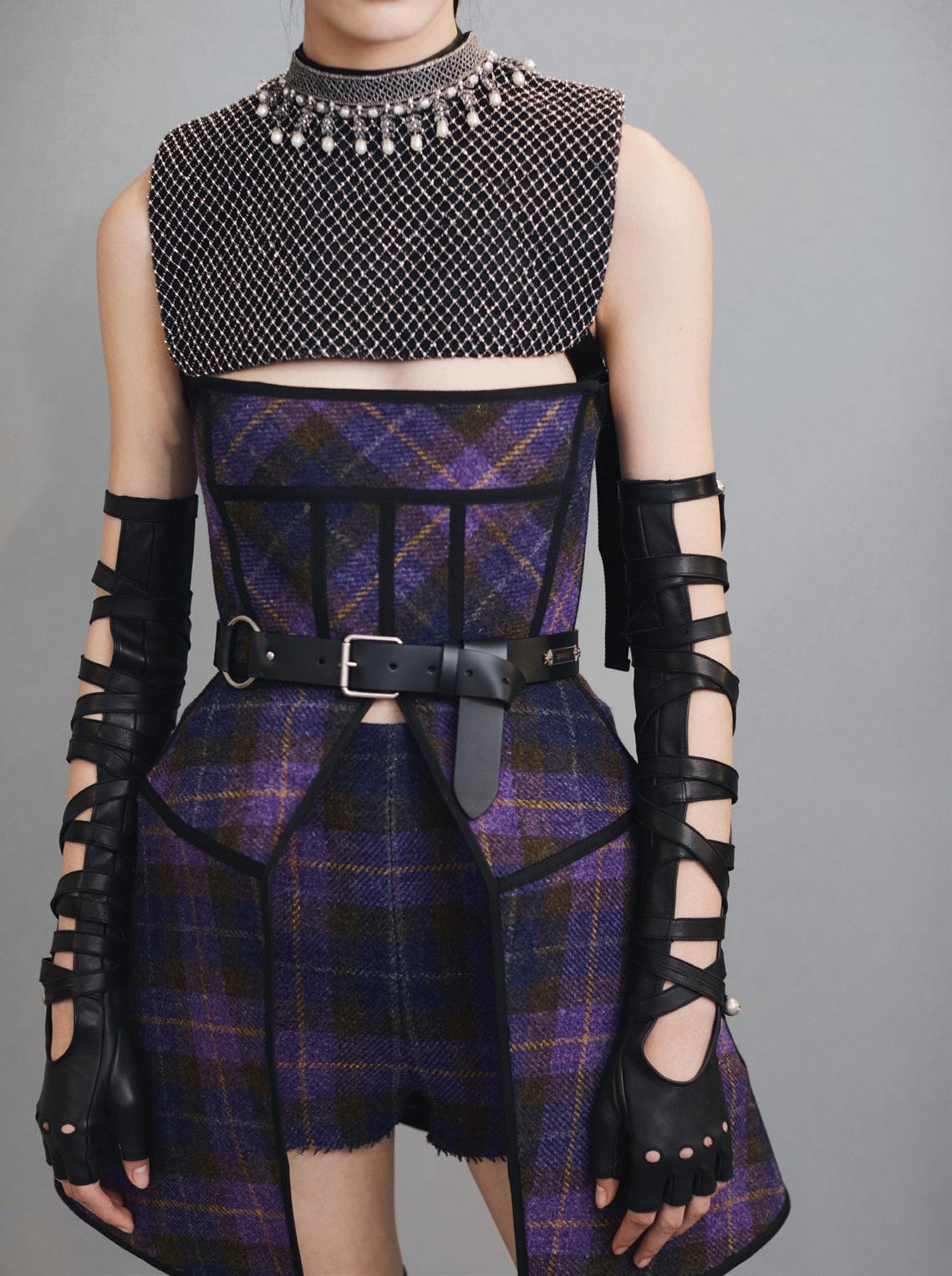
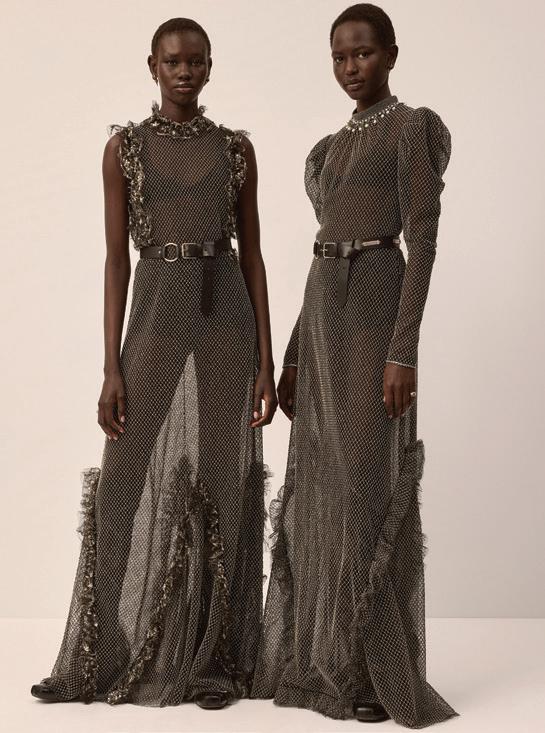
‘ It is important for me to pass on the message that the system can be disrupted ’
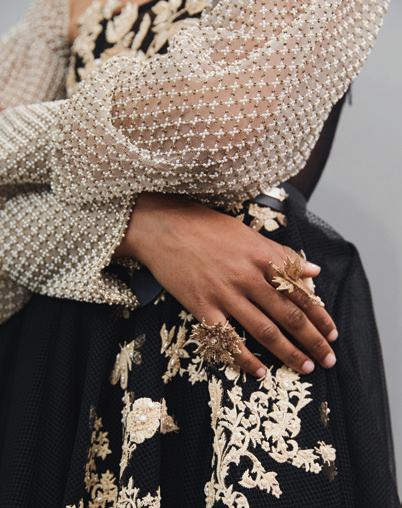

with functionality and clothes that I believe are truly wearable.”
It’s an approach — showcased via trousers cut with enough slack that the wearer can move in them freely and couture gowns crafted with (gasp) pockets — that has even earned her some criticism in the past. And she knows it. “The idea has often been that designing something that makes women feel good is a less creative way to design, but that makes no sense for me. I want people to enjoy the dress.”
Just as John Galliano’s era at Dior is remembered for its drama and Marc Bohan’s (“My favourite of all the Dior designers, we share the most in common,” Chiuri says) for evolving elegance, Chiuri’s Dior will come to be defined for rewriting the codes of femininity. “I was clear from the beginning that my point of view on femininity was going to be different. It was crucial for me to rewrite it in my language.”
Under her charge the house that gave us the New Look, with its waspie waist, has evolved into something freer. “There is a long-standing narrative that clothes have to be unfunctional to
be considered fashion. It’s so untrue!” Those who have followed Chiuri’s career will know that her feminist fight is not a solo endeavour. Indeed it is almost impossible to imagine a Dior show without background support from one of the many female artists she has collaborated with. Among them Judy Chicago — the American feminist artist with whom she has worked on numerous occasions, including the spring/summer 2020 couture show (staged in an inflatable shaped like a giant birth canal) and recently at an event at the artist’s exhibition.
Chiuri, who says she takes her inspiration in feminist literature from her daughter Rachele Regini, 27, has also worked with daredevil female Mexican rodeo riders and the Israeli feminist choreographer Sharon Eyal. She credits the five Fendi sisters — her first employers — for instilling in her the belief that women can do anything.
“Those women were and continue to be so important to me. It wasn’t just that they were open-minded, they gave me freedom, they never tried to slow me or stop me. They are my mentors.”
These days nurturing a new



generation of feminists to have the same level of self-belief is a vocation for Chiuri. “It is important for me to pass on the message that the system can be disrupted. As women I think we forget to trust in ourselves.”
‘ I was clear from the beginning that my point of view on femininity was going to be different’
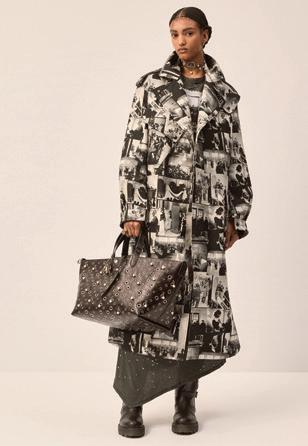
Without question Chiuri has earned the trust of the Dior CEO, Delphine Arnault — the eldest child of the LVMH CEO Bernard Arnault — appointed in 2023. More important, Chiuri has also earned Arnault a dollar or two: Dior tripled its revenue during Chiuri’s first four years on the team — proof that her cocktail of feminist energy and practical magic is going down well in all markets.
Undoubtedly there’s still a lot of pressure. “When I first arrived here, I had no idea how significant fashion and the house of Dior is to the identity of the country. What we do here doesn’t only affect the brand, it affects how fashion is perceived in France. I have studied a lot since those early days.” Chiuri spends a lot of time in the archive but she is not obsessed with it. “It is important to know your history if you want to do something new.”
The recent Cruise show, which saw the house of Dior retrace its steps back to the mirrored ballroom of the Gleneagles hotel where Christian Dior unveiled a collection in 1955, is an excellent example of Chiuri’s determination to look backwards and forwards simultaneously. At the lavish
Drummond Castle show, images from Dior’s original Scotland moment were printed on to trench coats and tote bags, which are certain to fly out of stores when they go on sale. “Since my childhood I have been fascinated by Scotland,” Chiuri says. “By the drama, the landscape, but it’s also such an important reference for Dior.”
As has become customary for Chiuri — and the extravagant Cruise shows that have grown in scale and influence during her time at the brand — the house’s recent show also provided an opportunity for the brand to give back, with collaborations with local artisans and designers. “I see the Cruise shows as an opportunity to discover more about the country we are visiting,” says the designer, who has previously chosen destinations such as Mexico City and Mumbai to showcase collections. “I really like to share the moment and share the platform with the community we are visiting.”
Chiuri has also taken her prefall collection on the road, with the most recent showcased in New York earlier this year. This, in addition to two readyto-wear collections and two couture collections, adds up to a huge amount of work for the designer. Certainly it’s a workload that has driven many of her contemporaries away from similar jobs.
But I get the impression Chiuri is unfazed. “For my kids, my husband, for me: fashion is life.”


One of the most enduring fashion legends in history, Marilyn Monroe’s style is now the subject of a new book
WORDS: CHRIS ANDERSON
Marilyn Monroe lived a short but eventful life and remains a significant influence on popular culture today. Much of this is down to her sense of style, with the actress perfecting the blonde bombshell look in the early-1950s and 1960s and becoming forever associated with a long list of iconic outfits.
Everyone remembers the white cocktail dress that Monroe wore in 1955 movie The Seven Year Itch, for example, standing over a subway grate in New York in one scene, trying to hold it down against a strong wind. And many recall the sparkling gown from French designer Jean Louis, featuring 2,500 crystals, worn by Monroe in 1962 as she sang ‘Happy Birthday, Mr President’ to US President John F Kennedy. That particular outfit resurfaced just two years ago at the 2022 Met Gala,
‘ Marilyn lived through lean years, which gave agency to her ambition to succeed ’
worn by Kim Kardashian, on loan from the Ripley’s Believe it or Not museum chain, which paid $4.8 million for it at auction back in 2016. But, truth is, while she may have been photographed or filmed time and again in form-fitting hourglass dresses, Monroe could look good in any outfit.
In her new book, Marilyn Monroe Style, published by ACC Art Books, fashion writer Terry Newman complies countless images of the star taken throughout her career. Some chapters focus on a particular movie, while
others a type of clothing, such as denim, swimwear, robes, and eveningwear. There are even sections on Monroe’s favourite designers, including Dior, Ferragamo, and Chanel, as well as the fashion houses she influenced, and the modern-day celebrities attempting to live up to her brand of glamour, from Madonna to Beyoncé.
Newman explains why Monroe’s wardrobe was such a rewarding topic to research. “It was central to the superstar she became,” she says.
“Through the clothes she wore, she crafted a playfully sexy persona adored by both men and women, and her legendary outfits are today instantly recognisable. Growing up during the Great Depression, Marilyn lived through lean years, which gave agency to her ambition to succeed. But as a young up-and-coming actress, she had only meagre funds, which meant



being resourceful, so the few outfits she had, she wore both on screen and off, accessorising them to change her look.” It was a modelling career that brought Monroe to the attention of 20th Century Fox and Columbia Pictures in the late-1940s. In her book, Newman shows an early publicity photo of Monroe from 1951, for the movie Home Town Story, and elaborates on the resourceful nature she would have been known for at this time. “Her supporting role as the secretary Iris Martin sees Marilyn wear a stylish two-tone jumper,” she observes. “She had worn the same a year before in another movie, The Fireball – a sweater that likely came from her own wardrobe, as it was well known for contract actresses to supplement their onscreen looks with their own clothes.”
Everything changed very quickly, however, and by 1953, Monroe had established herself as one of Hollywood’s biggest stars. Her role as a femme fatale in film noir Niagara cemented her status as a sex symbol, while the satirical musical comedy Gentleman Prefer Blondes, released that same year, gained her attention for her lavish, shapely outfits. In the scene where she sings ‘Diamonds Are a Girl’s Best Friend’, she wore a cotton candy pink gown and matching opera gloves from famed costume designer William Travilla, who years later would create the famous white halter dress for The Seven Year Itch When invited to the Photoplay Awards in 1953 to be named its Fastest Rising Star, Monroe wore a pleated ‘sunburst’ waist-tight, deep décolleté gold lamé dress, made by Travilla for Gentlemen Prefer Blondes, but barely seen onscreen, with its plunging neckline and open back. Apparently, the dress fitted her so well as a result

‘ Fashion changed her from a lonely orphan to an actress with her name in lights ’
of Travilla sewing her into it on the night. The result earned Monroe even more publicity, prompting Hollywood veteran Joan Crawford to call it “unbecoming of an actress and a lady.” Newman notes how Monroe’s sense of style grew alongside her fame. “She quickly learned how to look good on camera and worked hard to craft a visual brand that sold in Hollywood,” she says. “So successful was she at the sensationally seductive, witty and warm roles she played, that her fans expected the ‘onscreen Marilyn’ offscreen too. And she never disappointed. In February 1954, despite the freezing cold, she sang to the American troops stationed in South Korea wearing only a bugle-beaded, sequin shift dress. In her characteristically upbeat fashion, she described the trip as ‘the best thing
that ever happened to me. I never felt like a star before in my heart.’”
But what seems clear is that Monroe was aware she had a separate Hollywood persona. Away from the cameras, she was happy to rely on a classic, minimalist wardrobe of trousers, jeans, white shirts, coats, cashmere sweaters, and simple dresses, bringing back the glamour when required. “In 1955, when she set up her own production company with Milton Greene and began to attend the Actors Studio in New York, she was spotted regularly wearing a favourite beatnik black turtle-neck jumper and stripy capri pants,” Newman adds. “Many of the dresses sold at Christie’s auction of her personal property indicate that Marilyn had more of an affinity for a casual look.”
In photos taken by Sam Shaw in 1957 in the grounds of the house Monroe shared with then-husband Arthur Miller in Roxbury, Connecticut, the actress wears a countrified pale blue dress, and in an image taken at her home in 1962, the year of her death, she is back in her black sweater, trousers, and high heels. “Marilyn felt relaxed in trousers, but also knew she made them look good,” Newman elaborates.
Whatever the occasion, Monroe’s fashion choices were pivotal, propelling her to the height of fame in one sense, but helping her to relax and feel herself in others. “Fashion has a transformative quality, and Marilyn understood how the bombshell uniform she assembled enabled her rise to superstardom,” Newman concludes. “It changed her from a lonely orphan to an actress with her name in lights, and a lasting symbol of glamour and influence.”
Marilyn Monroe Style by Terry Newman is available this month from ACC Art Books accartbooks.com
The McLaren 750S is not only the most powerful series production supercar it has ever produced, but also its most enjoyable
WORDS: JOHN THATCHER

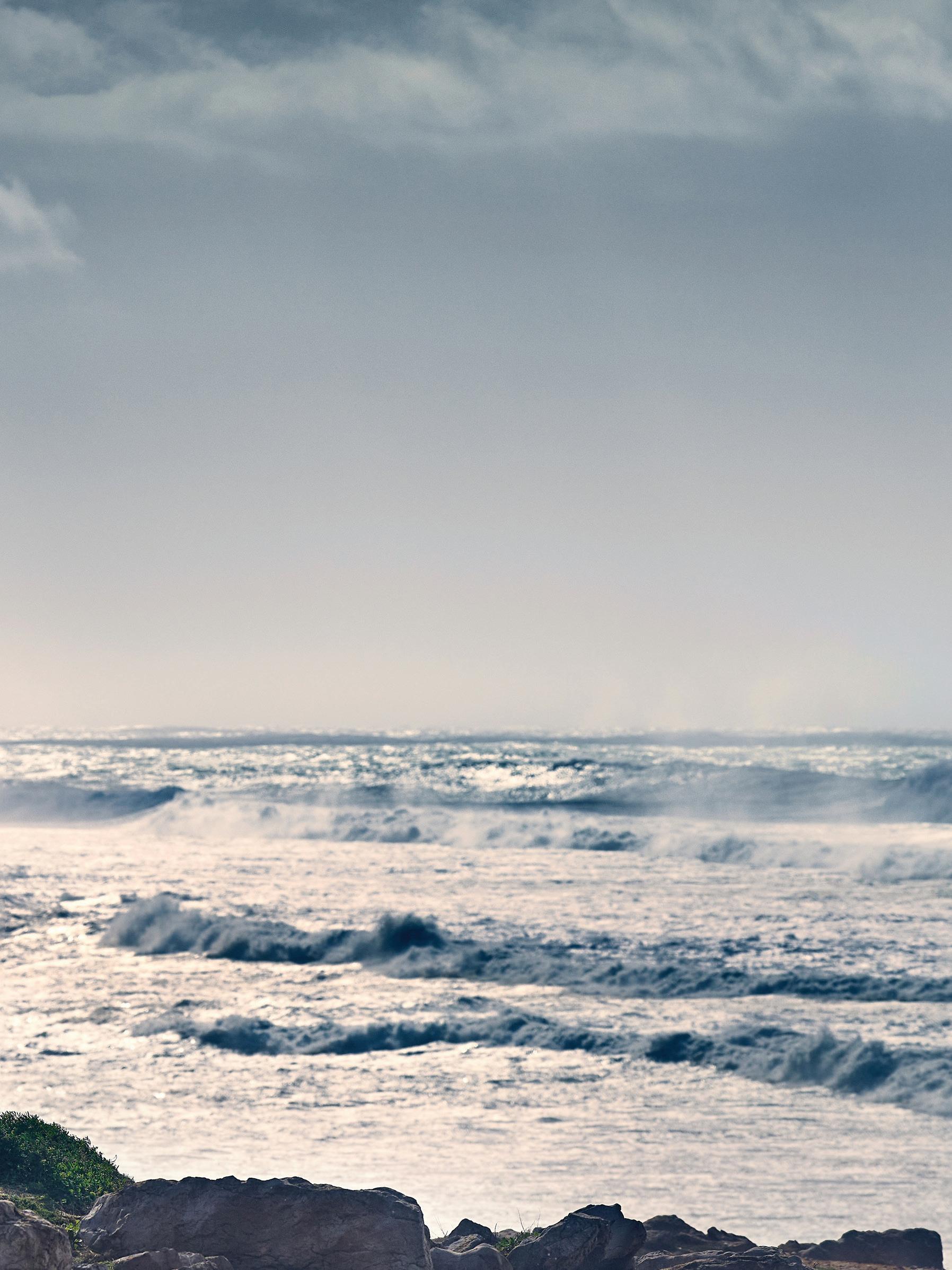



Despite supercars being as ubiquitous as sand in the GCC, you can still count on a McLaren to turn heads. The 750S is a beautiful looking thing, its sculpted body resembling something you’d expect to find hidden away in Area 51, the creation of beings from another planet. Which is quite fitting, because this is a car that is, in many respects, otherworldly — the lightest and most powerful series production supercar McLaren has ever produced, in fact.
Little wonder it caught more than a few admiring glances.
Those who mourned the loss of the 720S will find their mood swiftly lifted once at the wheel of its direct descendant. Because not only is it lighter — by 30kg, which makes it 193kg lighter than its closest competitor — and quicker off the mark, but it’s also more thrilling and engaging to handle. Incredibly so. In all, McLaren has utilised its formidable F1 knowhow to introduce or change 30% of components from the 720S, and you can feel the difference.
I drove the Spider version, so I also felt the rush of the summer wind. It comes fitted with a Retractable Hard Top, which tucks itself away neatly within 11 seconds of you pressing a button – and can do so at speeds of up to 50 km/h, though better to do it when you’re navigating speedbumps, which the 750S will quickly raise its nose to hurdle with the click of a button. There is also the rather nice addition of a retractable window at the rear of the seats, which I’m told is for increased ventilation, should the need for it grab you. However, this window’s actual purpose is to allow you to hear
‘It sounded like I had awakened a Tyrannosaurus rex from its 65-million-year slumber. And he wasn’t very happy about it ’
the inimitable roar of the car’s twinturbocharged V8 engine, which delivers 740 hp, 30 more than its predecessor.
It’s doubtful 30 horses in a stampede would make more noise.
For the past year I have only owned EVs, which for the most part are obviously as quiet as a mouse that has taken a vow of silence (I didn’t opt for the fake engine sound option, believing that it sounds far too, well, fake). So you can imagine both my surprise — and the sudden spike in my heart rate — when I pressed the start button and the birds in the trees scattered into the sky for safety. It sounded like I had awakened a Tyrannosaurus rex from its 65-million-year slumber. And naturally, he wasn’t very happy about it. Neither were my neighbours. As the father of two teenage children, I’m used to hearing a disagreeable tone whenever I ask them to do anything, or just enquire how they are, so I’m not fazed when the 750S reacts with a surly growl at low speeds. It wants me to stretch its legs, to open it up so it can show off. And well might it. The 750S is capable of shooting from 0-100km/h in 2.8 seconds and of
hitting 200km/h from a standing start in just 7.2 seconds (the Spider does so in 7.3 seconds). It’s exhilarating, to say the least. As it moves rapidly through the gears, you can’t help but fall for the sound it makes. Lie does the man who claims not to think about impersonating it with childlike glee — though best to do so with the roof up, for obvious reasons. It handles magnificently well and — unlike most cars these days, which have been engineered to the point of making the driver feel more of a bystander — you feel the need to take charge, the steering and braking granting you the opportunity to fully engage thanks to lightweight springs and dampers. You can change the way the 750S drives, and consequently the way you drive it, by selecting Powertrain and Handling modes from easy-reach rocker switches located either side of a mounted binnacle – the McLaren steering wheel is button free. As you’d expect from their names, the Comfort, Sport and Track settings take you out of your comfort zone to one in which you could conceivably deliver record-breaking lap times.
Of course, some clients will buy a 750S purely with the track in mind, but in Comfort mode the ride is still so enjoyable you’ll want to get behind its wheel every day. Its interior is certainly comfortable enough to do so — trimmed as standard in Alcantara but with two additional interior themes available — and there’s a fairly deep frunk for storing a few bags.
A rarity for supercars, the 750S also grants its driver exceptional visibility, with a near perfect view of your surroundings likely to take in all of those admiring glances.




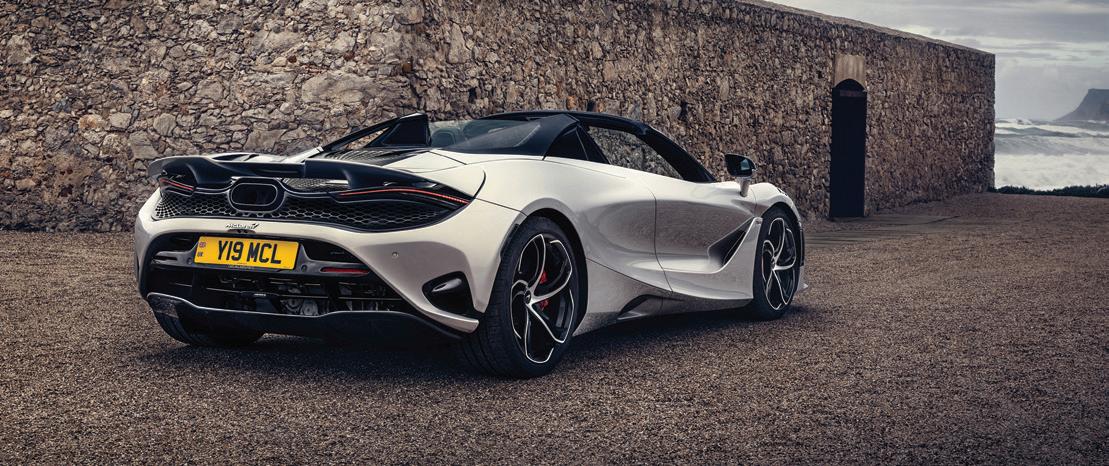



Ciccio Sultano was always hungry for more. Hence, while most chefs are content to write their menus, Sultano has written a manifesto. In its 28 pages you’ll find all the ingredients that define who is – “I feel sharp as a lemon. I think like a lemon” – what he does –“In a nutshell, a cuisine and way of life that is sustainable” – and how he does it – “Meticulous research of ingredients, stories and technique.”
The lemon references are plentiful. Sultano further describes himself as an “intrinsically zesty man”, one given to share “with a varying level of zest”, while the manifesto itself is printed on natural paper derived from recycling citrus residues. This is not the result of an irrational obsession, rather a reflection of the ubiquity of lemons in Sicilian culture: its cuisine, fabrics, art and ceramics.
It is Sicily, the island of his birth, that is Sultano’s true obsession. He lives it, breathes it, sustains it, and through his culinary endeavours – most notably the two Michelin star Duomo – draws in a cast of thousands from far and wide to get a taste of it. Via its 8,000 table turnovers per year, Duomo generates an influx of 30,000 people to the tiny, magicallooking town of Ragusa Ibla.
Sicily is no stranger to foreign visitors. Across millennia, Phoenicians, Greeks, Arabs, Normans and Spaniards have all made their mark, which feeds into Sicily’s unique cuisine, a melting pot of ideas and flavours.
“I live and work in Sicily and I think Sicilian. My cuisine is Sicilian by birth and international by vocation. And this depends both on history – it’s crucial that past dominations have left us a legacy of an incredible variety of ingredients, techniques and recipes – and on my curiosity about how the world changes.
“Being Sicilian is a blessing, not because of feeling proud of one’s origins, or because of attachments to one’s roots, but because of the perspectives it gives. Geography is a point of view and Sicily is a panoramic viewpoint over the world. In fact, given that the whole of civilization seems to have passed through here, you don’t need to look too far afield. Stories, ingredients, techniques, and recipes all exist in plain sight for everyone and, for most Sicilians, exist in their palates.”
Like most Italians, Sultano can trace his love of food to his grandmother’s kitchen. “Around the age of nine I was thunderstruck by my grandmother’s fresh homemade pasta and lemon granita


spread on homemade bread. Then, I realised, I was no longer eating just for hunger but to taste, for the experience.”
A few years later, aged only 13, Sultano took a part-time job in his local pasticceria (pastry shop), impressing the owners so much with his passion, tenacity and enthusiasm that they offered him a sevenyear apprenticeship. He made a similar impression – this time on the diners – in the next episode of his culinary adventure, a spaghetteri, where his unique influence on the restaurant’s menu delivered his first flush of success.
Opening his own restaurant in Sicily became the goal. But to equip himself with the necessary skills, Sultano left his homeland on a quest for knowledge, first to Germany to master meat cooking, then to various kitchens in New York, where he learnt much from celebrated ItalianAmerican restaurateur Lidia Bastianich.
By 2000 he was ready, and opened Duomo. Within six years it had scooped
two Michelin stars, which it maintains today. Ever since, it feels fair to say that Sultano has worked for Sicily, the food that feeds his soul.
“We are not inattentive and we know that, today, the strongest appeal is for a straightforward cuisine, connected with nature, linked to place and climate.
“Every year, the tasting menu changes radically, following a new thematic flow, discussed and chosen in good time,” outlines Sultano. This year the theme is citric and zest (naturally), but in other years Sultano has gleaned inspiration from other aspects of Sicilian culture, including the island’s female saints and goddesses. Yet it’s the island’s producers, their sustainable practices, and how they treat their staff and wider community whom Sultano continues to pay homage to. Freshwater fish comes from an aquaponic farm; fruits and vegetables are grown organically by a social cooperative; cheese comes from a farmhouse, where
it’s been made by the same family for close to a century; while meat comes from cattle that spend the duration of the year outdoors.
It’s a passion. A life’s work.
“Opening the restaurant every morning already represents the best satisfaction and motivation in life. More generally, I know that I have contributed, and continue to contribute, to making Sicilian and Italian cuisine more and more important in the world.”
Naturally, it was the advice of a fellow Sicilian that Sultano cites as the most influential to his career, a bar owner named Vincenzo Corallo. “He was my mentor in life and in the job. I also owe him two fundamental rules of life that I live by: knowing how to say sorry as an adult, and knowing how to get back up when you fall.”
Two rules we can all live by. Particularly when life throws you a lemon.
‘ Being Sicilian is a blessing because of the perspectives it gives ’


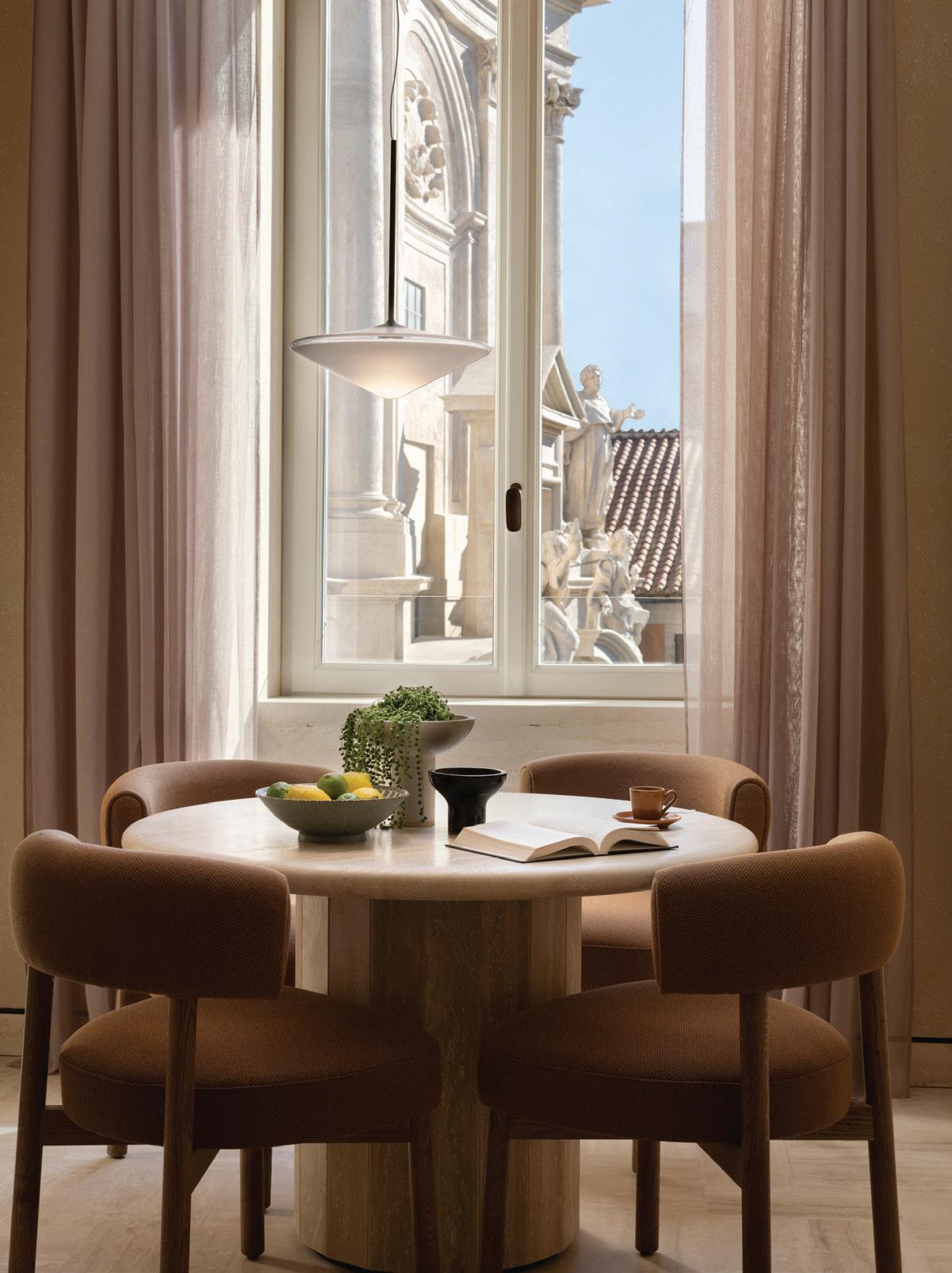
How the Six Senses Rome blends the ancient and modern for an urban retreat full of warmth
You can’t help but marvel at the history that surrounds you.
Constructed in an 18th-century palazzo, that itself was built on the site of a 15th-century palace, its façade UNESCO listed, Six Senses Rome rightly flaunts its inherited heritage. From the beautiful marble staircase and lovingly restored 600-year-old columns in the main entrance, to the glass floor tiles in the hotel’s restaurant, which reveal an excavated baptismal bath that dates to the fourth century, this is an urban hotel with a genuine sense of place.
It’s a feeling underpinned by the warm welcome and ever-accommodating staff who never once forget my name.
When it comes to wellness – which along with sustainability is one of the brand’s chief calling cards – the Roman tradition of bathing, once so entrenched in daily life that it came to symbolise the city, is marvellously modernised. Arranged as a 60-minute circuit that’s designed to warm then cool the body in varying water temperatures that you dip in and out of, it’s a wonderful experience that’s complimentary for guests. What the Romans didn’t have was a biohacking room: here, smart tech is used to optimise your body’s natural healing process, getting you to peak condition in double quick time. Then there’s the visiting practitioners, experts in a broad range of therapies. As luck would have it, celebrated physiotherapist Emma Diani was a much welcome visitor while I was there. As the sufferer of ongoing back issues, I booked an hour’s treatment with
her and learnt more about my spinal issues in those 60 minutes than I’ve gleaned from 15 years of consultations with doctors and physios. Startling. You can also partake in programmes specifically designed to detox your body of toxins and get a good night’s rest, courtesy of a consultation with the Sleep Doctor, who may sound like a villainous Marvel character but is a hero when it comes to mapping out a pathway to guaranteed rest. Not that you’ll really need them – the rooms have bespoke mattresses and are instantly comforting, while despite the hotel’s prime location next to Via del Corso, the city’s main thoroughfare, you don’t hear a peep at night. The rooms themselves are beautiful, mixing a raft of modern conveniences with ancient Roman decorative techniques and local art. Some feature greenery-festooned terraces. Book a Corner Suite and you’ll be blessed with views of Piazza di San Marcello and Via del Corso, while the fabulous façade of San Marcello al Corso Church – the renovation of which was sponsored by the hotel – greets guests at the window of the Two Bedroom Lata Suite, which also has a huge terrace. Fine vistas are also a commanding feature at rooftop bar NOTOS, which opens to embrace sunset with a creative cocktail list and light bites. Downstairs, BIVIUM is the all-day restaurant that’s big on locally-sourced ingredients and seasonallydriven dishes, though breakfast in its sunlit courtyard is its real highlight. Just one of many at this splendid hotel. MG
‘ The Roman tradition of bathing is marvellously modernised ’






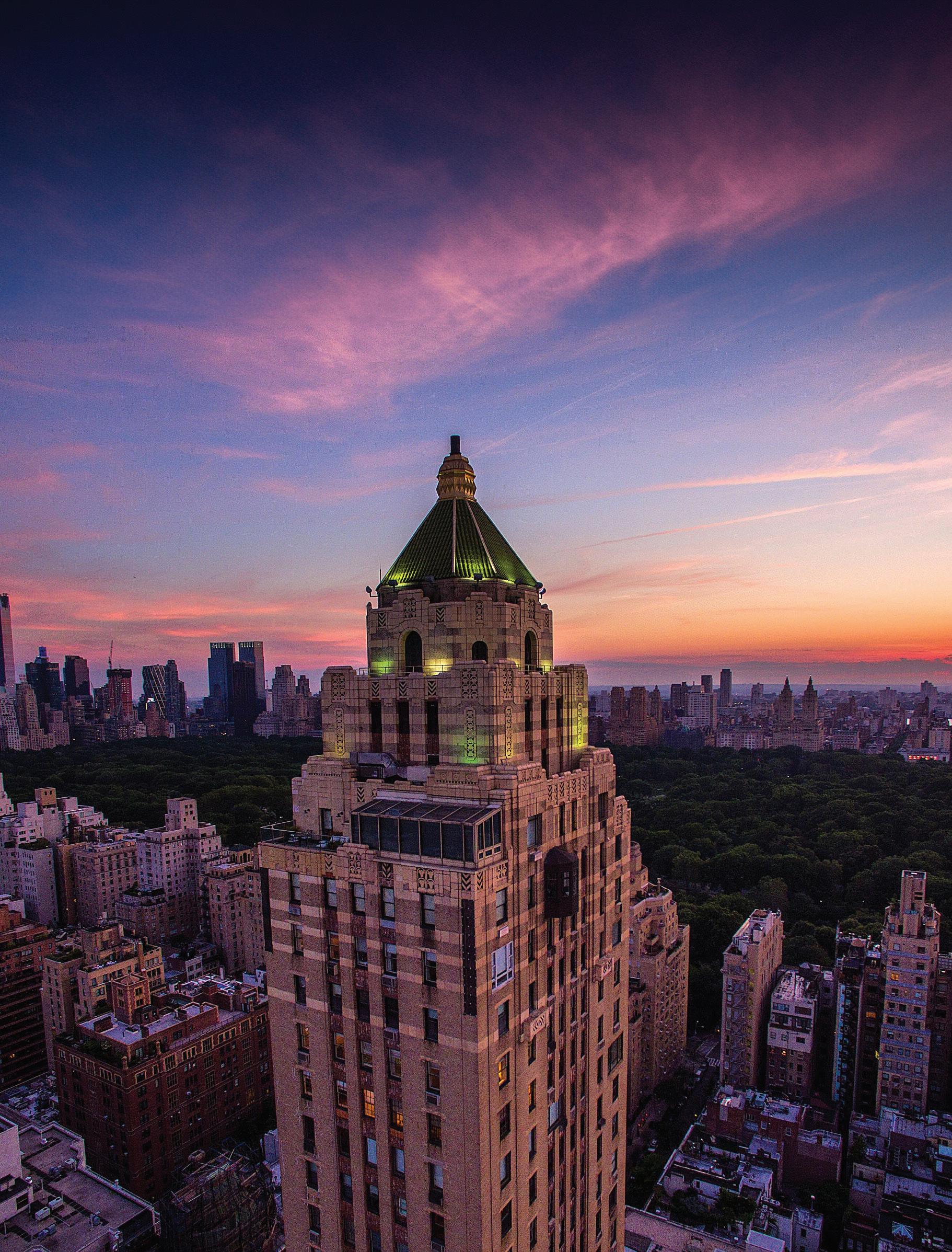





Nothing beats the classics. While there’s a buzz about new, ever-opulent hotel openings, and a clamour to be among the first to stay at them, the pleasure of stepping inside a hotel with an illustrious heritage – where if the walls could talk they’d regale you with fascinating tales for days on end – can’t be bettered. As one of New York’s most storied hotels, there’s enough we already know about The Carlyle for the walls to be spared a task.
Now a Rosewood Hotel (who will also open a property in Doha early next year), it has been a landmark on the city’s well-heeled Upper East Side for close on a century, standing a block away from Central Park in the thick of the luxury boutiques that line Maddison Avenue and world-renowned art institutions and galleries, including the MET. The strong Art Deco influence of its design, which has touchpoints throughout the hotel, is courtesy of its first interior decorator, Dorothy Draper, and though other noted designers have since had a hand in its appearance, Draper’s legacy has been beautifully preserved. As has the much-loved work of Madeline author and illustrator Ludwig Bemelmans, whose large scale, playful murals of Central Park decorate rooms and public areas, most notably the hotel bar that bears his name. And if Draper and Bemelmans have left an indelible mark on The Carlyle, The Carlyle has made its own lasting impression on the city’s social landscape. This is no more apparent than at the aforementioned Bemelmans Bar. This is the type of hotel bar you see depicted in the movies – alive with music, chat and laughter – only this has been the real deal since 1947. There’s a cover charge to enjoy the jazz trio and the price of a cocktail will make you wince (the fact that the bar’s ceiling is covered in 24-carat gold leaf sets the scene), but you’ll be glad you’ve paid whatever’s required to enjoy what is a quintessential New York bar experience. You’ll also likely spot a celebrity or two.
Since its opening in 1955, the big names have also flocked to Café Carlyle, the hotel’s ever-cool supper club, which continues to welcome a wide range of noted performers.
Having only opened in 2021, Dowling’s at The Carlyle can’t call on the same history, but this beautiful dining room, every inch of its walls covered in art, is a fabulous spot for dinner.
The suites here are also something special. Overlooking Maddison Avenue, the one-bedroom, hardwood floor Carlyle Suite, where we stayed, is every inch the archetypal Upper East Side apartment. It’s certainly large enough to live in, while its considered design makes you feel instantly at home, with an entrance hall, large living and dining area, bathroom, powder room, and dressing area all well sectioned: close the door and it’s easy to forget you’re actually in a hotel. Book one or both of the adjacent single rooms and this suite becomes two or three bedroomed, with its own entrance. At the top end of the suite scale, the Presidential Suite already has three bedrooms, along with a private elevator, piano, sweeping views of the city’s iconic skyline, and a history of accommodating royalty, headsof-state and virtually every US president since Truman. In fact, during the Kennedy years, The Carlyle became known as ‘the New York White House,’ so lengthy were his stays.
You can fully embrace the history at The Carlyle, but the story of this legendary hotel still has many new chapters to write. JT


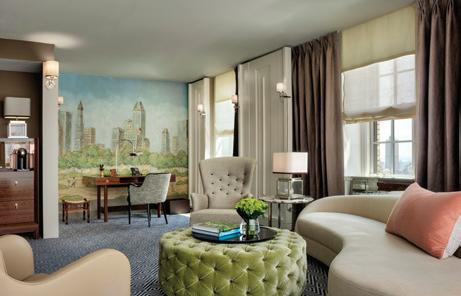


FOUNDER AND CEO, MB&F
I was incredibly lucky in the early nineties at Jaeger-LeCoultre to work with the great Günther Bluemlein. One day at a product meeting I had the courage to debate with him (he was a very formidable person) over a product design. He let me take it to the point where he just stopped me in my tracks by saying, “Creativity is not a democratic process.” I have applied that saying my whole life – I listen to all, but ultimately I decide. There can never be radical innovation through committee. It is always one person’s responsibility to take that bold and difficult decision.
My greatest achievement is that over the last twenty years, be it in easy or tough times, in highs and in lows, I have always maintained the values my parents tried to bring me up with, and not cut any corners or done anything I would come to regret later on.
A lesson I learned the hard way was that it’s pointless to get over emotional when something upsets you. Focus your energy on the solution, not on the cause or on what triggers you. I had two stress-related ulcers, one at the age of 28 and one at 31. Both could have been avoided. Now, whenever a big issue happens, my brain tries to go directly to the solution, not the emotion.
I would love to be able to draw as well as my friends Eric Giroud or Fabrizio Buonamassa. I love seeing them sketch. It is always a very humbling experience for me.
For the better part of the last thirty years I have felt like a lonesome gazelle in the middle of the savannah – always on guard, expecting the lions, cheetahs, leopards or hyenas to pounce. Always thinking of contingency plans in case something bad happened. It has allowed
MB&F to survive and grow to where it is today, notwithstanding some horribly difficult years. It also means that I have not actually enjoyed all our successes and beautiful moments, because I am constantly thinking ahead. I have to learn that it’s not always about the next challenge.
If I could advise my younger self, I’d say be kinder to yourself and to those around you – not everyone is as driven as you. Also, be more generous with your time and attention to others. Getting a job done does not supersede being there for those you appreciate or love.
I don’t delve into politics, but I have to say that what I perceive of Barack Obama’s intellectual elegance, eloquence and capacity to interact with all levels of society in what seems like real humility (having never met him for real) has always been a source of inspiration.

Dubai’s only boutique beachfront resort, nestled in the most exclusive location on the Palm, is effortlessly sexy. It is where those in the know come to unwind, play, connect and explore. oneandonlythepalm.com
